
How To Twist The Copy Cat Tail
In which we describe the Original/Copy relationship, and how we can twist it to make jokes
(But before we go any further, a quick two para note on the quality of the cartoons featured in this website).
When it comes to the examples of joke natural history featured in any analysis of cartoons, one thing is for sure. What is not going to happen is this: the reader rolling around on the floor, laughing uncontrollably, at the introduction of each new cartoon. Because, at best, all we are likely to get is a smile, and at worst, a half grudging agreement that the joke is at least identifiable as a joke. So what is the reason for this mismatch between what seems like a legitimate expectation for quality humour and this other, less colourful, reality? Well, just as we expect a display case of butterflies to feature some of the most exciting and interesting species in the world of Lepidoptera, so we naturally expect the ‘specially picked’ cartoons in an essay on humour to be just that: special. But the truth is that a true collection of butterflies, or in this case cartoons, has to do justice to what’s really out there, and most of the species out there are not that wondrous to behold. Indeed many of them are dull, brown and small. Yet the unremarkable species are just as valid in terms of their ecology, evolution and classification as the really large and bright blue Morpho butterflies of South America that always catch the eye – because they are just so stunning to look at. It is the same situation then with jokes and cartoons, where much of material may also seem mediocre, for the very good reason that it is, in fact, mediocre. So although the reader expects and hopes that the humorous material will be special, the reality may turn out to be small, brown, and not even slightly irridescent. A disappointment likely be compounded by our great familiarity with the world of humour. Because our familiarity with butterflies is sketchy at best, but our expectations for things closer to home may be harder to satisfy, given that we immediately know if the best has been missed out, and that we have been handed a plate of beans.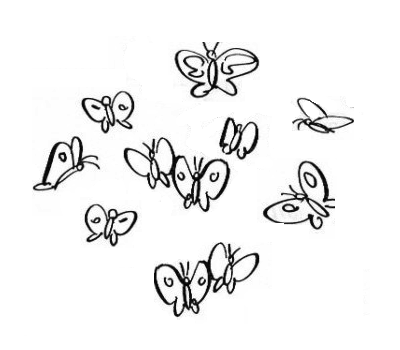
The point then is that each cartoon example featured in these sections is recognisably a joke, and that is all it has to be. We are not trying to make a dramatic display case of the very best specimens, but are actually trying to understand their diversity, and to do this, we have to follow where humour leads, and not start cherry picking according to the best laughs around. So no apologies for presenting the reader with a range of cartoons that are not hugely funny, and the best of the best (it would be nice of course, but it just doesn’t work that way, though some of the jokes are nice enough anyway). Though there is just one more point to make on this theme. Because something profoundly interesting happens to the flat two dimensional graphic of the joke when it is coaxed into revealing its innermost logic and working dynamics. In fact, the process is comparable to what happens when one of those dry and faded pieces of flat foam, so loved by kids at bathtime, is hydrated, to turn into the full and colourful figure of a flower or fish. Because however small and brown the cartoon is to start with, once it has been properly ‘hydrated’, its entire appearance changes. Not that it suddenly jumps out at us, with its characters standing free of the page, in full colour, larger than life, or anything as dramatic as that, but it certainly loses that brown look because of the way in which its meaning now takes on a greater significance. Greater because now it belongs to the wider currents of meaning that sweep throughout the human condition, making the single semantic snapshot of the cartoon part of a much bigger pattern of events. So that, far from ‘killing the joke’ by putting it under a magnifying glass – we give it new life.
How to twist the Original/Copy relationship – with cartoon examples
There are rather more than a dozen twists that attack the Original/Copy relationship. The three most common pairs are a set of twists based on the logic of
1) IMITATION
2) DISPLACEMENT
3) SIDESTEP
The first of these pairs of twists is based on the fact that the copy imitates, to a greater or lesser extent, the properties of its original. That, after all, is what the relationship between the Original and its Copy is all about. The twist then extends that imitation by taking it even further, or reverses it altogether by turning the relationship on its head, and making the original imitate its copy.
TWO IMITATION TWISTS

Here is a cartoon by that consummate artist and cartoonist, Michael ffolkes. The winning face of the salesman, and the baffled response of the customer help to dramatise the mismatch of expectations between the retail world, and those of the man in the street.
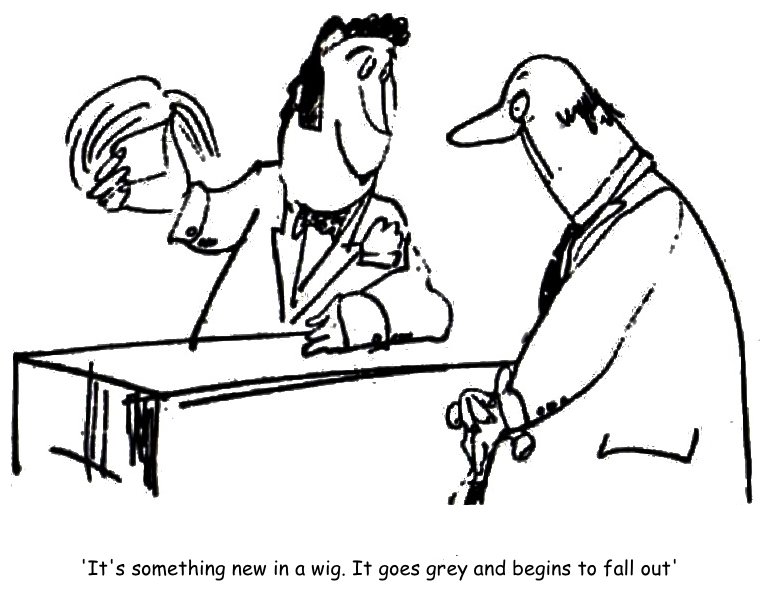
In this cartoon, the wig copy takes on what might be called the ‘negative properties’ of the original head of hair. The negative properties of hair are that it goes grey, and begins to fall out. Which is precisely why the wig was invented in the first place – it is a copy tailor-made to avoid these limitations. However, by imposing these unwanted and therefore negative properties on the wig, the joke calls the whole copy identity of the hairpiece into question, and the result is a radical twist. Radical, because it is one thing to make a copy imitate an extra property of its original, but quite another to make the copy imitate the very property, the loss of which is the reason for the copy’s existence in the first place.
Now because the twist denies the very purpose whereby the copy exists, a good legit is desirable, and probably essential. And as we can see, the legit in this case consists of a visual and verbal reference to the world of salesmanship. A world that frequently produces ludicrous claims in its ostensible drive towards the greater authenticity of its products. So the claim made here is that ‘It’s something new in a wig’, and the rationale behind this is simply that the more the wig imitates real hair, the better it must be. Which means that the legit derives from an area quite outside the Original/Copy relationship for its focus (namely, Commerce and Marketing). However, if we look more closely, we find that the basis for this commercial drive towards greater authenticity is, in fact, firmly seated in the logic of the original and its copy. Because a fundamental tenet of copy logic is that the more the copy looks and acts like its original, the better it must be. So the salesman is simply pursuing the logic of ‘copying fidelity’, except that it just so happens that this then leads to the point where it conflicts with the logic of copy advantage. Meaning that the legit from the world of retail cleverly balances the twist (denial of copy advantage) against another aspect of copy practice (increased copying fidelity), setting this latter aspect in the real world of salesmanship in order to give this apparently sensible logic a material focus. That is, the legit comes from inside the Original/Copy relationship, but steps outside it to gain an effective frame of reference. Adroit indeed.
The dynamics of the wig cartoon can be summarised in two ways. As a listing of the sort we have been using already, or as a diagram. So first, here is a sample listing of the kind that we might surely expect a clever computer of the future to spew out. I can almost hear the clatter of the printer now.
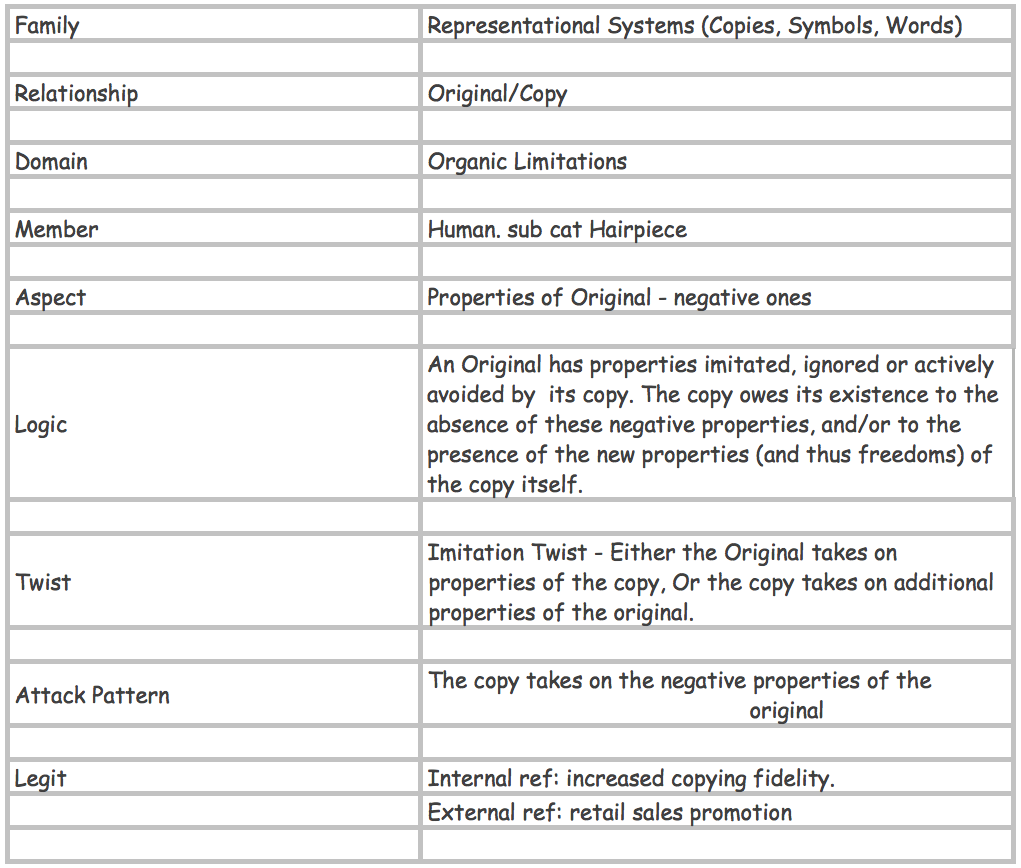
How then do we present this logic in diagrammatic form? Because surely so much information must be simplified for a diagram to work? Well, there seem to be three stages for consideration here: 1) the abstract logic of the move made from normal reality to the joke, 2) the rather less abstract focus on the particular relationship being twisted, and 3) the very definitely and most specific details of the actual example.
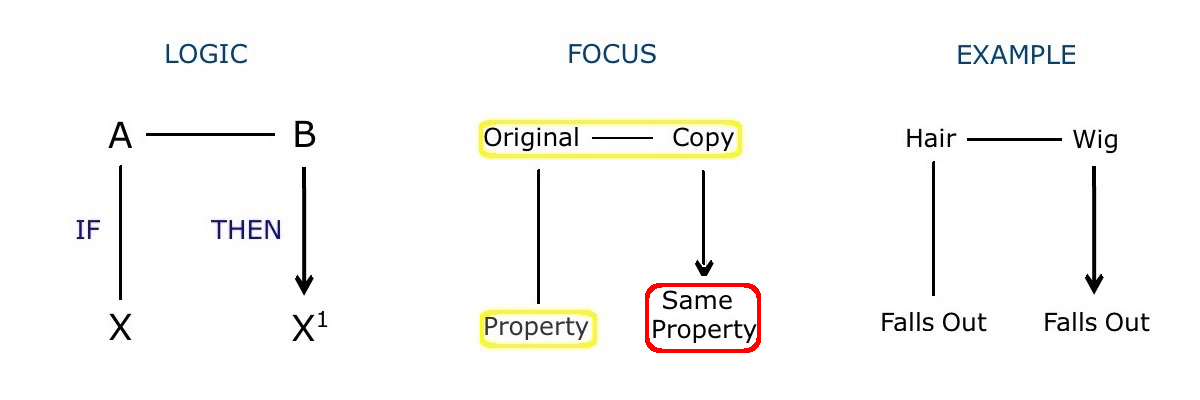
The logic of this twist is based on the parallel made between, on one side, the original head of hair, where the hair falls out, and on the other side, the wig copying that hair, where the hair does not fall out. The twist is like an argument: if the hair falls out, then why not the same with the wig? The counter arguement would be: well, wigs exist precisely because they do not have that limitation. But then the legit argues that the new wig makes sense after all, because the more the wig can behave like its original, the greater the fidelity of the copy. So the same property is then gifted to the copy along the lines suggested by the first diagram: If A has X, then B, which is close by A, should be given an X as well. For which the arrow then shows the final action of the twist.
Now let us consider what amounts to a less extreme version of the imitation twist. Again, the copy will behave like the original, but this time without taking on the negative properties that deny its validity as the copy in the first place. Which means the copy must take on other properties that clearly derive from the original, and yet ones that don’t compromise its overall function as a successful copy. All of which seems likely to reduce its force as a twist, at least in theory, because now it can only be about a limited form of imitation – taking on what are merely innocuous properties rather than outright negative ones.
For example, we might picture an exercise bike that has been customised to the extent that it can be used to ‘Go shopping whilst taking Exercise’. In other words, it has taken on the mobility that it sacrificed in the name of domestic convenience. A ridiculous idea given that the principal difference between the original and its copy in this case is that the former moves, whilst the latter stays in the same place. We see a parallel in the idea of the ‘open sandwich’, where instead of referring back to the origin of the sandwich as a piece of bread with food sitting on it, we instead define it in terms of the sandwich itself, as if the preceding and original stage never existed. Thus the real bike is the inspiration for the exercise bike, and the next innovation is therefore the exercise bike that you can take outside in the street. But far from being something new, this is really just the original idea, looked at through the identity of its immediate precedent, the excercise bike. So it looks as if it is innovative, and thus the next step forward, when really it is a step backward. Which is why this twist is similar to the idea of the open sandwich.
The next question is, how do we legitimise such a silly idea? Well, we can look to the drive towards copying fidelity and marketing again (so allowing us to maintain a valid comparison between this idea and the wig twist). This is indeed what we see in the sales claim about ‘going shopping whilst exercising’. Pushing this further, we might also claim that it makes it ‘easy to move around at home too’. Because mobility is not a negative property for the copy to take on as long as it can be stood up, and used for exercise when needed. Note that it is probably the legit rather than the twist that attracts the most interest here, as the joke idea is much weaker than the wig twist, which uses a negative property to create the twist. The result being that the idea of the exercise bike twist is unconvincing, and so the joke is rather weak. All of which suggests that an imitation twist is best when it tries to deny the whole point of copy advantage. Not least because we then need a strong legit to hold the twist in place, and the combination of the two makes for a dramatic arguement between what are, in effect, these two claims to meaning.
So what the example of the exercise bike seems to be telling us is that an imitation twist that carries a strong legit will still not succeed if the twist itself is weak. Now admittedly our only evidence for this evaluation of the twist is our own reaction, versus our reaction to the wig example. But there is also a theoretical corroboration to this assessment, because it seems clear that an imitation twist that copies the negative property of its original is more extreme, and therefore more dramatic, than one which merely imitates a more neutral property (such as the mobility of a real bike). So perhaps this aspect of the imitation twist really does make sense, and perhaps we can start to discuss the quality of a joke idea, just as much as its dynamics, and on a relatively objective basis, because that certainly looks to be the case already.

In the next example, the imitation twist is turned completely on its head, and the original is made to behave like the copy. But notice that there is an asymmetry here: because while copies are created in order to behave like their originals, the original owes no allegiance to its copy, and stands, as it were, proudly on its own. Meaning that if we then do oblige it to behave like its copy against all normal Original/Copy reasoning, then the result is likely to be striking, as in the following example.

This cartoon is splendidly simple, and very effective in its visual message. We see a landscape that is behaving like a watercolour painting with particular respect to one property. Namely, that it runs in the rain.
Notice how a number of useful tricks have contributed towards the effective presentation of this twist.
1) Firstly, the identity of the relationship twisted in this cartoon is made clear by the practice of inserting a reference to a copy within the body or context of the original. This neatly addresses the problem that the presence of the original on its own does not immediately remind us of the Original/Copy relationship (whereas a copy on its own does). Again, this is all about the asymmetry between the two, where the original exists independently of its copy, but not the other way around. So what about the practical side to this copy reference? Well, fortunately, in this case, the copy painting not only fits into its original in the physical sense but also, due to the presence of the landscape painter, it fits into the landscape from the human practice point of view. For without the artist, the presence of the watercolour painting, hanging on the branch of a tree, or leaning against a wall, would look odd, given that the natural home for a finished watercolour is hanging on a wall inside, rather than outside. So this particular combination works perfectly well, and the problem of reference to the O/C relationship is therefore overcome.
2) Secondly, the two frame format advances a proper development of the twist by showing the ‘before and after’ that spells out the causal sequence. This enables the cartoonist to cleverly remind us of the particular copy property that is to be imposed on the original – the watercolour artist is seen to take shelter from the impending rain to protect his painting from damage – so we are left in no doubt as to the property at issue here. Now if McLachlan had drawn the first frame without any rain, and then shown it coming down full torrent in the second frame, without warning of an impending change in the weather, then that would have been less effective. Frame one would have shown the landscape (and no rain), and frame two would show the fait accompli of the artist hiding and the landscape running. This would remove the active link between the two frames, where we see the causal sequence that involves the artist looking up at the sky, and his responce, thereby giving us an abrupt transition that would call on us for its resolution. Alternatively, if he had used just one frame for the whole twist, with the landscape running and the artist hiding under the tree, then our enjoyment would have been compromised, not so much by our having to work harder to make sense of it all, but because the dramatic contrast between the normal scene in frame one, and the extreme consequence in frame two would have been lost.
3) Thirdly, the cartoonist is able to exploit a happy chance in how to present the picture effectively. We note that the image is completely convincing in the way the ink runs down the ‘page’ of the real landscape. The reason that it is so impressive being that the image really is running in the rain (well, the cartoonists equivalent, which is presumably very carefully controlled drops of water). A technique that comes directly from the fact that the cartoon drawing is itself a copy – and an ink drawing at that – so it can be made to run in exactly the desired way for the joke to work perfectly. In short, this is a cartoon that can exploit the very real property of running ink whilst pretending to be, for all intents and purposes, the portrayal of a genuine landscape. In fact, we might say that the cartoon drawing is exploiting the freedom of its own copy nature to more effectively propose the twist because it shares the same property as the property exploited in the joke idea itself.
Now, without this craft, all of which involves a proper understanding of the joke idea for the presentation to succeed, the joke might have either faltered or even died stillborn. On the other hand, with these practical issues and aspects turning out to fit together so well, the twist and its visual presentation work together perfectly. So what then is the comparable logic of the twist in the terms of the wig joke that we have just looked at? Below, we see the dynamics of this twist in the same useful diagrammatic form that we have seen above. (This usefulness becomes particularly clear when different twists are compared with each other, as we shall see later on).
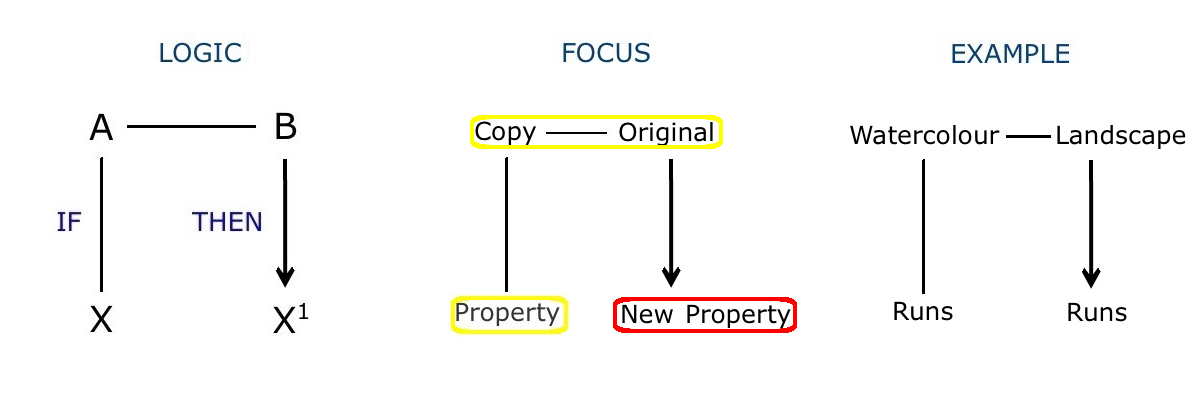
Note that the Original/Copy pair, which in this case includes the property of the copy being imitated, are here shown in yellow. This indicates that we are looking at the normal state of affairs, prior as it were to the attention of humour. And clearly the right hand diagram shows the particular form of the Original, Copy, and Property used by the cartoon to carry the twist. Which is to say that in this case, the Original landscape has been made to take on a particular property of the watercolour painting depicting it. Namely, that the watercolour is bound to run in the rain.
The next issue is the legit. Which is quite a problem in this case because we see nothing in the cartoon that legitimises what is incontestably a dramatic twist on the laws of nature. Now, there is no caption to carry it, although the caption is normally a favourite place to put the legit, as we shall see later on. Neither is there any obvious support for the twist inside the picture itself. Yet despite this lack of legit, the force of the twist seems undiminished, and certainly the result is pleasing. So what is going on here? What makes us accept the sense of what is a hugely radical twist on the laws of physical space in this two frame cartoon, and to do so gladly?
The answer seems to be that it is the visual authority of the drawing itself that gives this particular twist its authority and credibility. That is, it is actually the reality of the visual representation that makes us take the whole joke seriously. After all, we see the whole thing happen before our very eyes, which may not be as good as actually being there, but it is not far off. Or, to put it another way, the visual reality of the cartoon is almost as good as the best legit of all – reality itself.
The principle that reality is the best legit casts much light on a familiar comment often heard at the conclusion of a poorly recounted anecdote or supposedly funny experience. The comment, usually proposed in a lame and regretful voice, is ‘Well, You had to be there!’ And what this means is that such events really need to be witnessed directly for the humour in them to be properly appreciated. Indeed, the comment is tantamount to saying: “If you’d been there, that would have secured the twist”. Or we might say that in this case, the told joke, with its verbal ‘You had to be there’ is exchanged for the visual ‘You are there!’, and it is the authority of this latter principle that we see in the landscape cartoon above.
If this really is true that the ‘You are there’ of an image can justify a twist, then why do so many cartoons employ verbal legits, when surely all they have to do is rely on the visual authority of the image to justify themselves? Well, the answer seems to be that where a twist works on a purely physical matter, as in the landscape cartoon, then visual authority may well carry the day on its own. But when a joke involves social logic, it has rather more to answer for. That is, a joke that involves social logic seems to need a legit that draws from social logic as well, because social logic is too abstract to be carried by the visual dimension. In which case, we should predict that legits for twists on social logic would find their chief expression in the verbal form of the caption, and this is indeed what we frequently find.
One of the pleasing aspects of the landscape in the rain cartoon is its simplicity. There is only one twist, and the legit is achieved through the economy of the medium itself. The nature of the twist is also simple, featuring only the physical aspects of the relationship. So the complex of social connotations and connections that attend a twist on matters more directly human is absent. This is also why there is a lack of resonance in the cartoon, and why there is what might be described as a poetic stillness to its presentation.
Before we move to the next example of a twist on the O/C relationship, let us just look again at this asymmetry between the ‘O like C’ and ‘C more like its O’ twists. To repeat, for an original to imitate its copy is more radical than the reverse – copies already imitate their original, so the move to further and greater levels of imitation is not a big step. So really we should talk about the ‘Copy MORE like its Original’ twist because that way, the asymmetry is explicit, given that the other member of the pair is ‘Original like Copy’. We can also express this asymmetry in another way:
Contradiction is more Radical than Exaggeration because it points in the Opposite Direction
That is, the copy points in the direction of its original, so its action in further imitating that original is simply an exaggeration. Whilst if the original is forced to imitate its copy, when normal logic dictates the reverse, then this results in a contradiction of that logic.
It is only with the ‘C like the Neg Props of its O’ twist that we again find an attack pattern as radical as the ‘O like C’ twist. An exaggeration so extreme that the whole logic of ‘copy advantage’ is turned on its head, making it equal to a contradiction, which is effectively what it turns out to be. So a good example of an imitation twist where the copy behaves like its original should involve this more radical logic because exaggeration is all very well, but contradiction is more dramatic, and thus more effective.
TWO DISPLACEMENT TWISTS

Thus far, we have discussed a pair of twists based on the imitation of ‘properties’. But objects in Social Space have other dimensions, and one of these is the ‘context’ they normally find themselves in. So in humour, as in other domains of meaning, there are twists that displace the members of various relationships into the context that belongs to their counterpart. For example:
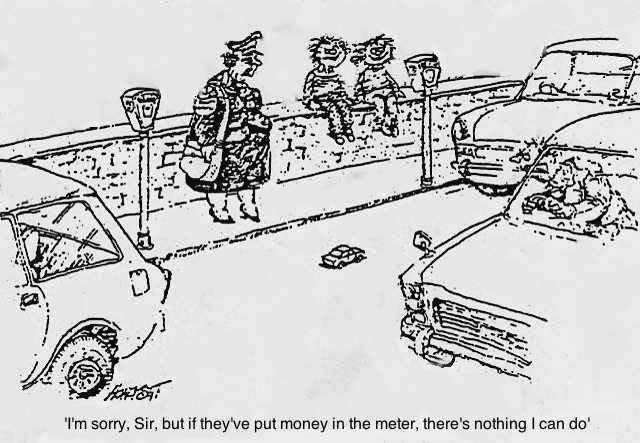
Here are the joke dynamics in diagrammatic form. Items that are actually visible in the cartoon are shown in blue. For example, the real car is marked in blue because it is shown in the frame. And in this case it helps that we see the real car in the picture, because although a reference to the original in this kind of displacement twist is not always needed, it does no harm if we are explicitly reminded of the relationship being twisted. However, the discerning reader will notice that the real car depicted here is not the original of the toy car in the same way that the landscape in the previous cartoon is the original of the watercolour painting. This is because it has no direct one-to-one link with the toy car like the painting does with its landscape. Which is the rule for most copies, because they imitate the generic original, rather than a specific example. But the world of art is different, because there the link between the original view and the painted or sculpted copy is direct (just as with prosthetics or personal items like false teeth), making the relationship that much closer.
So, let’s put the twist in this cartoon into the semantic scanner, and see what the printout reveals.
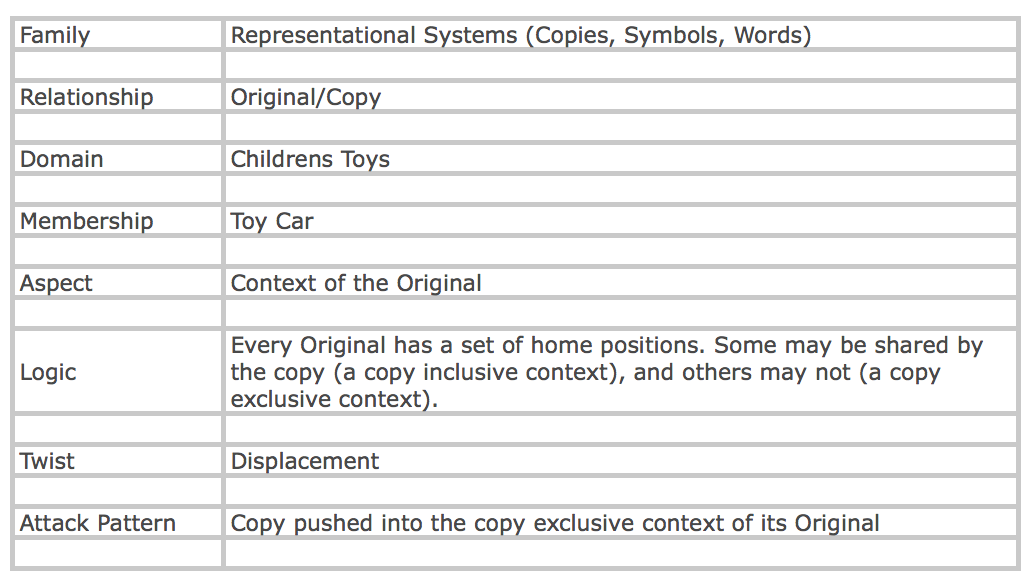
But there is surely more to this cartoon than the listing shows here, because we also have to account for the personal friction between the human protagonists as a whole. So whereas the two O/C cartoons that we have looked at so far only involved one twist (and might therefore be described as ‘pure forms’ of that relationship), the ‘Money in the Meter’ cartoon is about rather more than just the O/C relationship. And in cases where there are more than one twist involved, it is worth stripping the cartoon down, to then rebuild it, stage by stage, till we get back to where we started. So let’s see what happens when we do this in this cartoon, taking it down to the bare bones of the displacement twist to start off with.
Stage One – The Bare Bones
The ‘bare bones’ in this case means that we remove all the human players, leaving just the toy car parked in the space of a real car. A process that gives us a simple visual statement, shorn of human participants and social context, and bereft of legits. To the extent indeed that we may not even properly recognise that the little car is intended to depict a toycar (given the absence of the kids that then make this absolutely clear). A process that certainly results in a weaker cartoon, because we have now removed the second twist, to do with authority, which contributes so much to the cartoon. But there is also another factor that weakens the bare bones cartoon. Because the fact is that the displacement twist is not, on its own, a strong twist to begin with. So why is it that displacement twists are weaker, for example, than imitation twists?
The problem seems to do with what is possible or probable in real life. So, the displacement of an object, in this case a toy car, is often easily arranged in real life, even though there may be no obvious reason for actually doing such a thing in practice. For example, it is physically possible to do what these kids have purportedly done, and place a toy in the adult context of a parking space. We are not bending the laws of the physical universe by doing so – that much is clear – though we are bending human practice in this instance. However, and this is the critical point in the comparison here, imitation twists are more radical. Thus, in an imitation twist, the imposition of a property that normally only belongs to one side or the other of the original/copy pairing is a less likely occurence because it is practically more difficult to achieve. Moving a toy car from one place to another is much easier than modifying a toy car to look more like its original.
The principle being that it is generally easier to imagine a thing being moved than it is to it being physically changed in some way.
Properties are a fixed part of the object, but the object is not a fixed part of a context
because it can be made to fit into different places. It may indeed be easily moveable, whilst changing one of its properties may require a much greater input. So, in simple practical terms, property addition or reduction is more radical and more difficult to achieve than movement of the whole unit. And in humour, it is often the ease with which a twist can be achieved in real life that lessens or increases its worth as a joke. Because although jokes always start off with the commonplace (a relationship), and often knot the twist with a commonplace as well (the legit), the twist that lies in between these two must propose something special, or the value of the joke is much reduced, or even lost altogether.
But is this really true that the movement of an object is easier to imagine or achieve than the change of the property of an object? Well, certainly it does seem a lot easier to say, move a slipper from its normal place on the floor to the inside of an oven than, say, change its physical character in some way. Yet there must be other examples where movement is not such an easy optiion. For example, mountains are notoriously hard to move (which is the reason for the saying about faith moving mountains), and it would seem easier to blast a piece out of the side of a mountain, or grow a forest on its slopes, than shift it any distance from its original position, plate tectonics notwithstanding. So the principle that property change is more radical than change of context is clearly a generalisation with obvious exceptions. However such exceptions are clearly visible to the audience that hears a joke, and are always taken into account when evaluating the twist.
Stage Two – Restoring the Kids
Put the kids back in the cartoon, and suddenly the scene is more colourful. There are still no adults present, and as kids are normally expected to play with their toys, there seems nothing particular surprising going on in this picture. They are just having fun, playing at being adults through the agency of their toy car. But less this seem too cute for words, it rather depends on whether we slot the kids back into the picture as innocent children or as little monsters with the manic grins we find in the original cartoon. Because if they are not so innocent, then we will need some explanation as to why they are grinning in such an evil way. And as no such explanation is available (through the presence of the two adults), this makes no sense at all. All of which leaves us with a cartoon that has a bit more to it than before, as the kids certainly add some action to the scene. And we can appreciate the displacement of the toy car here too, but kids do imitate adult behaviour, so it is not that surprising or untoward to see it parked in a real parking place. Clearly then, we need to bring back some vital element to make this cartoon a bit more interesting, and that means bringing back an adult.
Stage Three – Restoring the Angry Car Driver
Put the driver of the real car back in the scene, and suddenly there is a potential conflict between the kids and the adult. Put an angry look on the drivers face, and that potential conflict becomes an actual conflict. But would this scene with the angry driver stand up on its own account (and without the traffic warden)? Well, it would, just, but it would be hard to see why the driver didn’t remove or even drive over the toy, and park there without more ado. Or for that matter, laugh it off, and drive away to find another space. Because as long as the motive behind the childrens behaviour is innocent, the displacement seems to break no rules, and simply counts as play. But if the kids are pictured with their manic evil grins, then the driver would likely take the law into his own hands and park there.
Stage Four – Restoring the Traffic Warden
Put the traffic warden back in the frame, and all the force of that most official and adult of sanctions, the Law, is in play. Suddenly it all makes sense that the driver is unable to take things into his own hands, just driving over the toycar, and perhaps crushing it for good measure. (Finding a parking spot can be very difficult, so there is plenty of energy available for fury in this context). It also explains the perhaps disproportionate anger on his face, because although the kids are obviously enjoying the situation beyond measure, it is the impotency of the driver in the face of the unquestionning legal system that has made the situation so much worse. The kids have paid, and the meter maid is ready to stand by them, however ludicrous the result, and however malicious the children’s behaviour, so there is nothing he can do.
So Honeysett has given what could have been a harmless and even charming displacement of the copy a hard rough edge by turning the children into monsters, the driver into a raging fury, and the already much unloved figure of the traffic warden into the mindless automaton of an inflexible bureaucracy. Tying up the driver and hapless warden (‘I’m sorry Sir… there’s nothing I can do’) in a conflict with two horrible children, and turning the normal Adult/Child relationship on its head. Creating an ingenious twist on that relationship in the process, complete with its own and improbable, but nevertheless possible, legit (‘they’ve put money in the meter’ and the toycar is, in principle, a car). Giving us a masterly demonstration of how to turn a physical twist into so very much more, by using it as the fulcrum for a conflict and contradiction within the logic of social space.
Note, by the way, that the legit is presented to us in the caption because there is no clear visual way of showing that the children have paid for the parking space otherwise (“I’m sorry Sir, but if they’ve put money in the meter, there’s nothing I can do”). This is why the caption is often such an essential complement to the visual side of a cartoon – it has the power to deliver non physical information that lies beyond the visual dimension of the cartoonists pen. And once there are human protagonists present in the picture, it is easy to put the caption in the form of a speech bubble or undertext to make it seem natural. In fact, the caption is usually the best place to look for the legit because the main effort on the visual side goes to the presentation of the twist and its consequences, and it is left to the caption to provide the rearguard action that ties it all in place. And as that action is to provide a legit, and as that legit is usually a reference to the logic of social space, and as that logic is usually beyond the scope of visual presentation, it is right that the caption should be the natural place for this all important facet of the joke.
What justifies this errant behaviour of the children though? Are we to accept that children are sometimes monsters, just like their adult parents? Or are we just in the know about the visual style of Honeysett, and therefore happy to recognise that he almost always draws his participants as bestial beings? Or is it just that we recognise a practical joke when we see one, and accept that it may be going a little too far in this particular case? Well, the practical joke is a common source of legits in humour, as we shall see elsewhere in the material we cover later on. The reason being that it can easily lead to all sorts of abnormal outcomes, all of them under this self serving aegis of humour. Yet it has a perfectly rational origin in our need for fun that happily serves as its continued justification. In other words, humour is using itself as a legit for its own twisted logic in what amounts to a ‘snake swallows its own tail’ scenario.
Even practical jokes have their limits of application though. So in this case, where the kids have put money in the meter in order to hijack the formal rules of adult dominion, we can see that they have gone beyond the bounds of normal behaviour. (And if the traffic warden goes away before the driver does, then we can imagine how this might develop further). Because the bestial malice on their faces makes one think twice about childish innocence being involved here. So although this is notionally a practical joke, whatever the depiction of the kids suggests, we have to concede that the result is extreme, and that the situation has gone, literally, ‘beyond a joke’. However, as normal reality does often go beyond a joke, and even routinely in the case of humour, no further level of legitimacy is required for this cartoon to maintain its temporary credibility.
But where Honeysett really succeeds in adding quality to the joke, is in his mastery of the legit. Because the presence of the traffic warden, along with the caption verifying the legality of the payment, is what locks the whole scene into its alternative and twisted sense. So although both the copy context and the status reversal twist between the two generations seem to deserve the credit for the humour in this cartoon, it is actually the sheer ingenuity of the legit that makes the cartoon work as well as it does. (Almost as if the legit was acting as a sort of containment device for the near explosive mix of malice, anger and stupidity that we find here, all ready to plummet into the chaos of hostility and retribution, except for the holding action of the support that Honeysett has devised through the traffic warden).
So maybe we should start to think that the funny thing about jokes is not the twist, but the legit that secures it? Which is an important consideration, because although the truth lies somewhere in between (clearly both are critical elements to any good joke), it is too easy to think that the joke is all about the twist, when really it is about the legit as well. In fact, the metaphor of the legit as containment device gives us a hint as to why we are likely to choose the twist over the legit as the key to the joke. Because the ideas of containment, support and legitimisation are a little dull when compared to the more dramatic ideas of the twist, attack and explosion. As a result, the legit comes second to the twist metaphorically as well as literally, so it seems less important in the scheme of things, despite the critical job it plays in the ingenuity and value to the overall success of the joke.
Notably, we have now come across another example of a status reversal twist (cf. the ‘Slipper in the Oven’ and ‘Think or Thwim’ jokes considered in a previous section). Where in each case, the underdog has flipped the normal power structure on its head, so that the weaker party is elevated, and the mighty are thereby debunked. But given that there are clearly two twists in this example, which is the one that gives the most value to the joke?
Given the two twists in the dynamics of this cartoon, it looks as if the primary part of this joke (in terms of its overall contribution) must be the status reversal and not the copy displacement twist. This makes sense because the O/C displacement is just a means to this much more dramatic end. Thus the kids are using their toy car, along with their meter payment and the presence of the warden, to secure the reversal in authority that leads to the consequent fury of the driver. Making the adults, and not the children, the butt of the joke. Leaving the adults caught up in a literal minded legality of their own making, and therefore hoist by their own petard. So the question here is: should we be surprised to find that this physical twist on the O/C relationship is secondary to this second twist on the human relationship between adults and kids? And the answer is probably not. After all, the second relationship is dead centre to the logic of social space, whereas the former is out on the margins as far as human meaning is concerned. To wit, further down, we look at another cartoon where the primary twist is indeed the displacement of the copy, just to see how it looks on its own, as a ‘pure’ version of the copy displaced to the context of its original twist.
But first, we can see that our deconstruction and subsequent rebuilding of the cartoon reveals a number of things about the joke dynamics in this cartoon. Firstly, that there are two twists in the picture: one is an Original/Copy displacement, and the other an Adult/Kid status reversal. Secondly, that there are a number of legitimising elements holding the two twists together. The toy is an honorary car, and kids do play practical jokes, and by putting money in the meter, the law has been satisfied. So both of the twists are locked into a logical knot, where the official is obliged to support the malicious behaviour of the kids, and the driver is obliged to do what he is told (which is why he can do nothing but gnash his teeth in anger and frustration).
What then can we say about the visual presentation in this cartoon? Well, Honeysett generally portrays human beings as monsters, with decrepit postures, bestial expressions, and either emaciated or obese figures. Which means the adults and children in this example are no exception to this rule. Thus the driver is snarling like a wild animal, the kids look like the devil incarnate, and the traffic official has a body as fat as a root tuber. In short, this visual presentation represents a full scale graphic attack on human elegance and dignity. Now, whether this is an effective or even acceptable visual style is, to some extent, a matter of personal preference, but it is certainly helpful to the workings of this joke. Because it is precisely the dramatisation of the facial expressions of the protagonists that reflects and indeed exaggerates the situation created by the pair of twists. And although the style of Honeysett is both cynical and even ugly in its presentation of the human race, it is ultimately a compelling one, so it does stand out, which is an advantage in the highly competitive world of cartoonists.
Now here is another cartoon example of a Copy being displaced to the context of its Original:
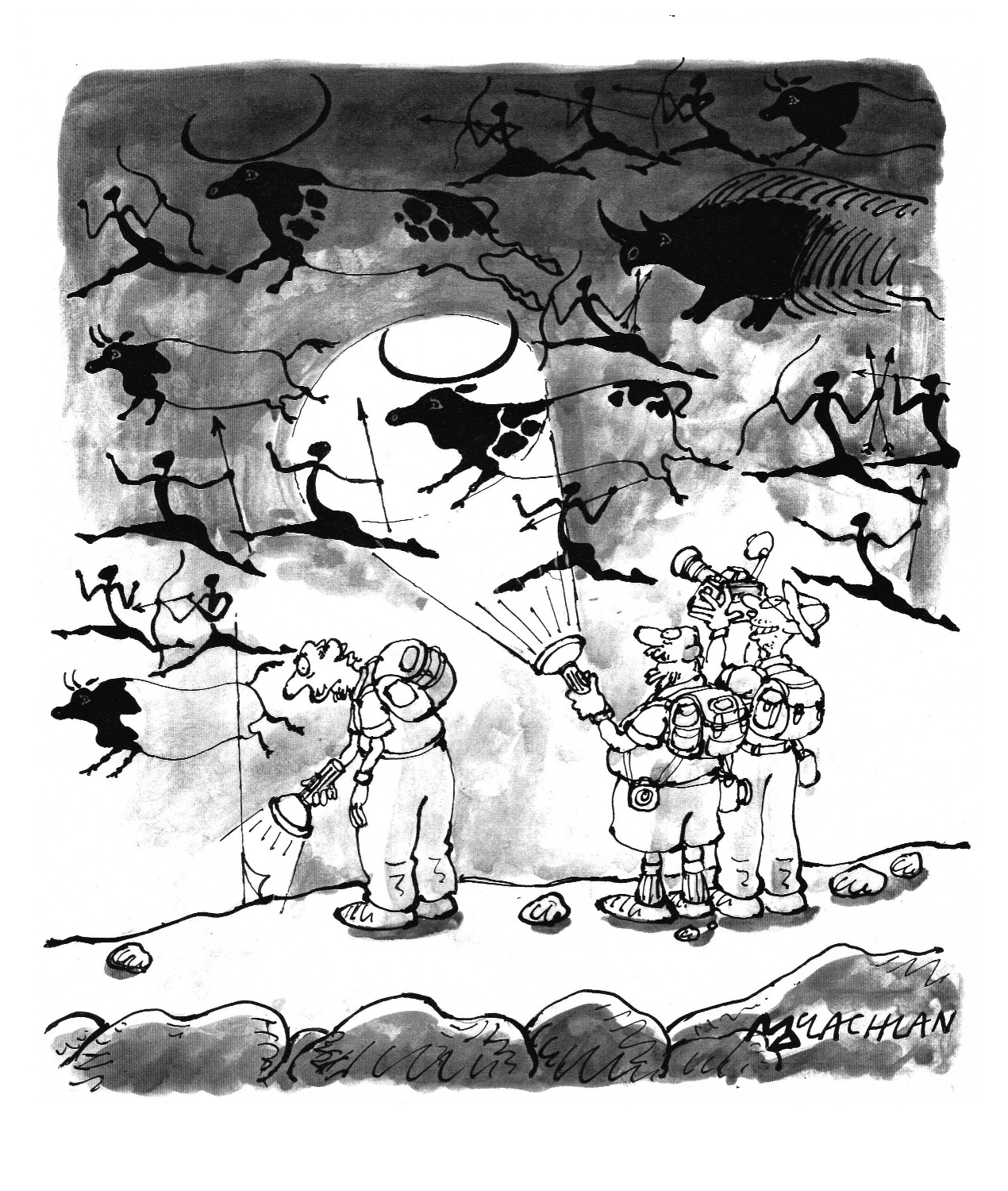
An apparently normal scene one might think, but being a cartoon, we know there has to be a twist somewhere. In fact the fuse has only a short time delay in this case – because in just a brief moment we spot the secondary focus of the image, and realise that the cave painting is actually a fake. A realisation that makes both the tourists and ourselves the butt of this joke. We are then left to decide whether the picture represents some kind of a practical joke, or is the revelation of a real fraud, when it seems either could be true, because the cartoonist offers us nothing in the way of an explanation.

Playing tricks on the audience is common practice in the world of humour, and cartoons are no exception to this. Indeed, we have already seen an example of this in the ‘Your Supper’s in the Oven’ where it is not only the husband that misses the pun. And usually it takes a two frame format to stage the deception and then the revelation, because that separation keeps the two interpretations cleanly divided. However, in this particular case, both stages are collapsed into the one frame, which is then divided into two distinct areas of attention. We look to the centre first, where there are two visitors, not one, and where they have a bigger pool of light emerging from their torch. Only then do we notice the other man, bent down in the corner, with a slightly puzzled expression on his face. We look to see why, and that is when we notice the tell tale curl in the corner of what suddenly looks like wallpaper… The deception has been revealed for what it is – a copy in the place of its original.
So the twist is clear. A copy has been moved to the context of its original – the cave has been pasted with a wallpaper that faithfully represents a real cave painting. In so doing, the copy now shares both the appearance and the context of its original. Making them effectively identical. So how do we tell the real thing apart from its copy? Well, we need to find a property that is exclusive to the copy, and then use this to flip our reading of the situation from one to the other, all with just a touch of the cartoonists pen. The ‘curling corners’ of wallpaper are a classic (and annoying) property of this particular copy type, so this offers us a good solution here, especially as the curl can be inconspicuous to begin with.
Notice by the way that the original cave painting is itself a copy – in this case to the original landscape that the cavemen werer trying to represent. This is quite common in copy rich cultures like our own, where the original is copied, and then that copy is subsequently copied to make a chain of O/C that may stretch out for a number of moves (eg. Famous Sitter for Portrait, Portrait, Photo of Portrait, T shirt of Photo). But in the past, copies occupied a much more valued position because they were often hard to create, and usually unique as a result. So when modern technology arrived, the cave painting became the property of everybody, rather than just the select few, being pasted around the world, to lose its exclusive value, to the point where it ended up as a wallpaper for the walls of our own caves in the process.
But back to the dynamics of this cartoon with an apparently innocent question. Which is, why should this curly corner persuade us to change our original reading of the scene, when it totally contradicts the normal placement of the copy? After all, we know that wallpaper is never found in caves, so why conclude that this apparent curl signifies the presence of a copy? For example, maybe this little triangle is an irregularity in the rock? Or maybe (and this is more far fetched) the cave painting is an example of the original imitating its copy, with the cave artist having had the foresight to catch out future visitors with a reference to a copy that never even existed during that period? Well, maybe, but in practice, we still have to explain what looks suspiciously like a join leading away from the corner as well. Making it hard not to see the whole picture as a case of wallpaper stuck on the wall of a cave. Because the presence of two different copy exclusive properties combine to make the reading of a copy displacement a near certaintly that is hard to argue with.
The cave painting is based on just one twist – the relatively straightforward physical displacement of a copy. But this is clearly a displacement in time as well (given the two very different periods of history represented by the cave and the modern invention of wallpaper). And it is this temporal disparity that takes the twist away from the almost purely physical logic of a simple O/C displacement, and into the realm of social space, where things become rather more interesting. More meaningful indeed, because it is the involvement of the visitors in the cave, and the invisible presence of the perpetrator of this hoax, along with their possible motive for the deception, that then makes this scene a focus of social logic. Which is precisely what gives the cartoon the potential for the resonance that so often enriches that second look and moment of reflection that cartoons, let’s face it, so sadly rarely get.
But being a resonance, it must rely almost entirely on the input of that othewise passive participant, the viewer. True, it is the cartoonist that creates the spark that leads to the resonance. A spark that generally works through the agency of the twist, because its anomalous nature is bound to raise an eyebrow and a question. So, for example, the cave hoax raises a question about who set up this deception, and why? Is this a hoax set up by the owners of the cave in order to make a profit? Or better still, is this a practical joke set up by the original cave dwellers, who were more advanced than we ever realised, and who knew we would be taken in by a copy? Or is it not even a hoax at all, but just that they really did use wallpaper in those days?
However, although it is in the nature of the resonance that such questions may loom around in our background appreciation of the cartoon, they are hardly central to the joke idea. They are just the loose ends that mark the frayed part of the two strings of meaning, otherwise knotted neatly together in the alternative reality of the visual presentation that the cartoonist sets before us.
Having seen two examples of copy displacement, we can now go on to consider whether the opposite of the ‘C in context of its O’ twist is possible. Because although symmetry suggests that the opposite case may exist, it is by no means always the case that there should be such an opposite…

Strangely, I found it impossible to locate an example of this potential twist in the cartoon literature. The idea seemed perfectly viable, but in practice there was nothing to support this in the material available. The next step was clear: think up an example to test whether this twist was actually a possibility in practice. For example, it was easy to imagine a game of Monopoly, where the piles of bank notes in the very expensive and exclusive special edition version of the game were, in fact, real bank notes, and not just paper copies. So, apart from this being a happy discovery on the part of the players, it would also, for our purposes, turn out to be a ‘revelation based on the original being found in the context of its copy’. Notice how the presence of a weak legit is already carried in the suggestion that it was a special edition of the game incidentally.
The result of this attempt is less than side splitting. But if the idea works well enough for us to say that it works, then where are all the other examples we might expect to find in the literature? Because it is not hard to think up other ideas along these same lines. For example, the use of a real bottle of whisky in the place of the normally safe fake whisky (often cold tea) drunk during the numerous ‘takes’ on a film set could also serve as a confirmation. Though this is an idea not best suited to cartoon humour because its development needs multiple stages, but it could work in a video. Again though, the result seems a bit banal – certainly it would have to be done well to get a laugh.
Finally though, I did discover a ‘wild’ example of a displacment twist that really did feature an original in the context of its copy in a cartoon – out there in the literature all on its own. To wit:
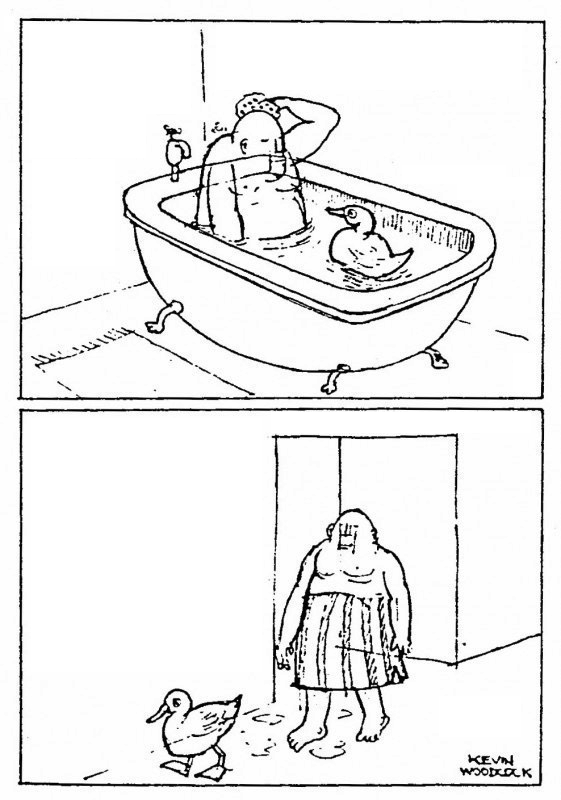

In the second part of the diagram, we see that the focus moves from the copy to the original – what we take to be a plastic duck turns out to be a real one. Notice that the twist is depicted on the right hand side as always, this making for ease of comparison within the listing of O/C twists.
Now, we can see how the cartoonist uses an exclusive property of the original living duck (its legs) to make the break from the deception to the revelation stage. Because this is the best way to show the displacement of the original to the context of its copy. A technique that we also saw in the earlier Cave Painting cartoon, where the cave image on the wall is seen as real right up to the point where we notice the tell tale property of the curved corner.
The problem with the duck in the bath cartoon is that such a displacement that could conceivably happen in real life, given the extent to which some pet owners get attached to their animals. So the surprise value of this displacement twist is therefore limited. Because the nearer the twist is to what people do for real, the less the impact for any joke that uses such a twist.
So, why is there such a shortage of ‘O in the context of C’ twists in the joke literature? Well, the problem with this particular type of twist is that it starts off with what looks like a copy (given the typical copy context) and this immediately reminds us of its original. So when the copy turns out to actually be the original, we are less surprised than we might otherwise be. That is, when the true identity of the original is revealed – the revelation itself is weak, thanks to the ‘semantic proximity’ of the two sides of the relationship. On the other hand, this does not apply to the opposite position where, as in the cave painting cartoon, we have no immediate reason to suspect the duplicity of the original. So, for example, nothing about the paintings in a cave would lead us to anticipate their substitution by a piece of wallpaper…
So there is an asymmetry in the O/C relationship, whereby the Original does not owe its existence to the Copy, but the Copy absolutely does owe its existence to the Original. An asymmetry that must therefore weaken the impact of any twist that turns a copy into its original. But where the original is suddenly revealed to be a copy, well that at least is likely to surprise us a little, which is why it makes the better and more common variation of this twist.
Reverting to our ducks for just a moment, is it possible that a copy duck actually occupies the same context as its living original, making the context displacement twist a non starter? Well, the answer is yes, if that copy duck in this case is a decoy duck. Because then the copy naturally occupies the same location as the wild ducks that the duck hunter is aiming to attract to that spot. In which case no displacement is possible in either direction. The same context problem also applies to, for example wigs, because their natural habitat is the head. But even here, wigs and decoy ducks do sometimes occupy their own distinctive context, such as the place where they are put on sale, and the place where they are made (the shop and the factory in short). So displacements with copies like wigs and decoy ducks are still possible, once that critical difference of context has been established.
Note. In the Oxford Exam Paper 2030 (in the Special Paper on Humour) section, there is a video that exemplifies the ‘O in context of C’ twist in a far more compelling example than the cartoon of the duck in the bath. It features a picture coming to life, with its occupant jumping out from his 2D world into the real life 3D world of an art gallery.
In the next cartoon, the twist takes advantage of a third dimension of ‘Objects in Social Space’ (see section with that heading). Meaning that objects in social space not only have a set of distinctive properties and contexts, as we have just seen, but also a third aspect that we might call their set of neighbours, and it is in this next twist pair that third feature gains its significance.
TWO SIDESTEP TWISTS

Just as the copy can imitate the properties of its original, or put itself in the original’s context, so it can be made to act as the basis for a new copy, based on an existing and accepted example of an O/C relationship. All of which becomes much clearer in the following example.
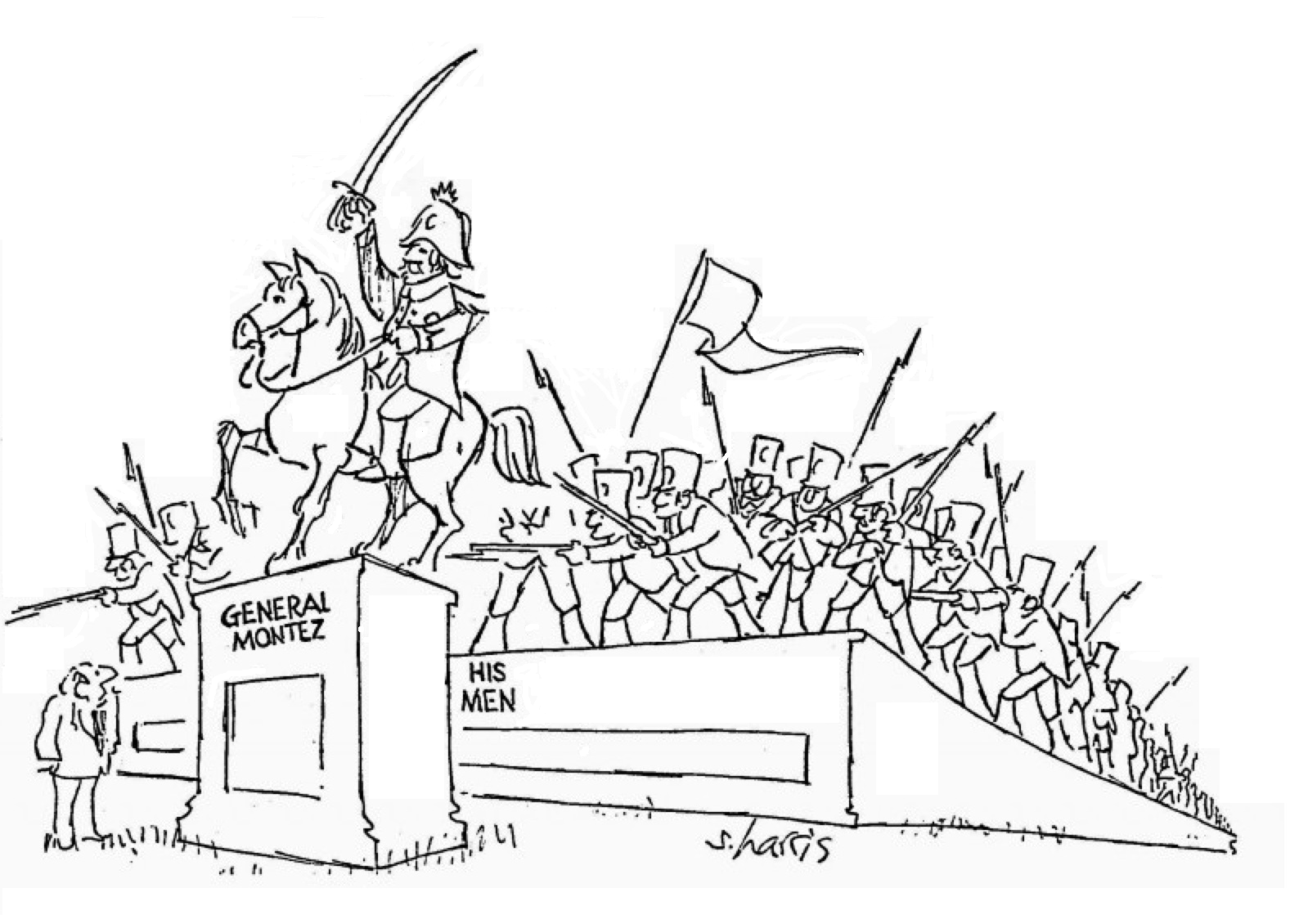
The underlying logic of this cartoon, with its sidestep through to a neighbour of its original, is best understood with the aid of a diagram. In fact, let us make this two sets of diagrams, because there are two possible representations of this cartoon to be considered in this case.
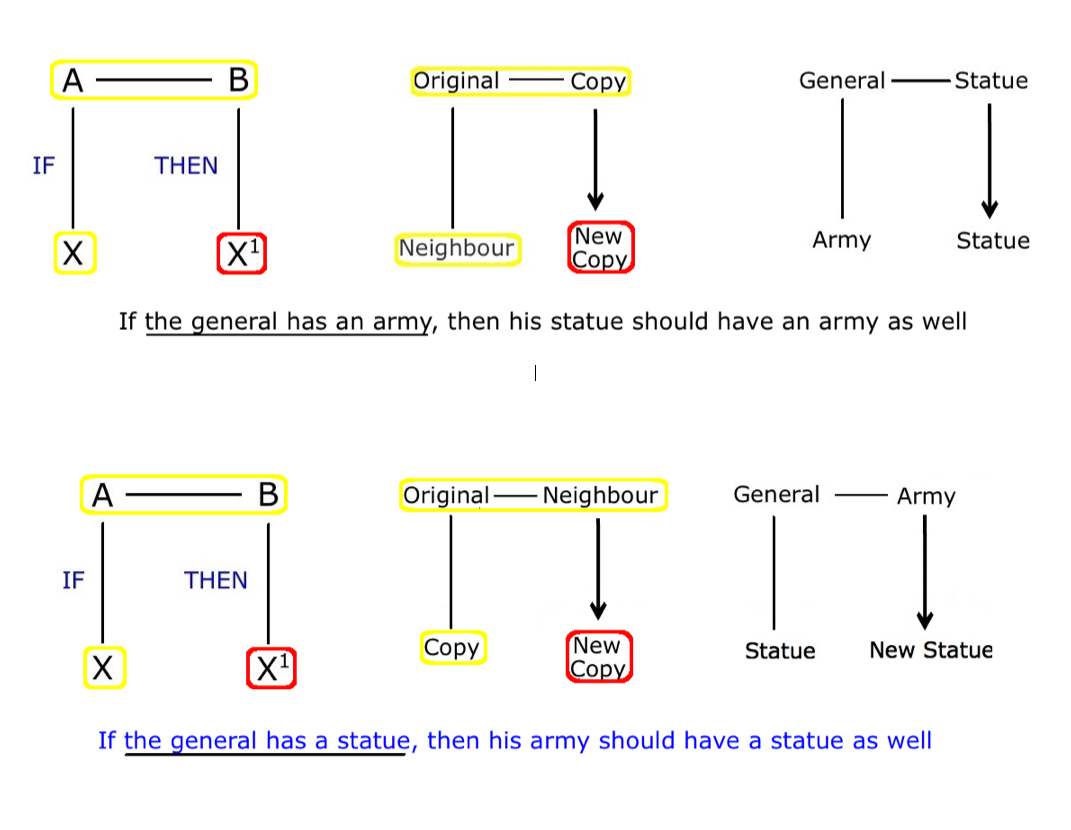
Which do we choose then? The first format, which is consistent with the format we have been using for twists on both property and context, or the second? Well, what we are going to do here is adopt the option that fits in most neatly with the progression we have already begun. An option that is about whether we keep the bottom left unit in sequence, so that it reads either Property, Context or Neighbour.
The second schema breaks with the pattern of the Original and Copy in position A and B (see middle diagram above). So instead of the normal ![]() on the top, we find it is
on the top, we find it is ![]() instead. But otherwise it fits in fine, with the twist bottom right as usual, and the arrow in the normal direction too. And that is the problem, because both ways of looking at the logic seem to fit the sidestep twist equally well. So we are just choose the one that continues our sequence, as above, so that X = Copy, and B = either Property, or Context, or Neighbour. Significantly, this also fits in well with a further development, where we then expand the third category of Neighour into three different categories, all based on the typology of the initial triplet (to produce property, context and category neighbours).
instead. But otherwise it fits in fine, with the twist bottom right as usual, and the arrow in the normal direction too. And that is the problem, because both ways of looking at the logic seem to fit the sidestep twist equally well. So we are just choose the one that continues our sequence, as above, so that X = Copy, and B = either Property, or Context, or Neighbour. Significantly, this also fits in well with a further development, where we then expand the third category of Neighour into three different categories, all based on the typology of the initial triplet (to produce property, context and category neighbours).
Nevertheless, it must be said there seems to be something about the way the second reading in blue argues the logic of this twist. Yes, if the general has his own statue, then his army should have one too. That sums it up nicely. But instead we are going for the Yes, if the general has his own army, then his statue should have an army too. However, and this is surely the main point, whichever way we look at it, all the main semantic points still obtain, showing that the sidestep twist is exploiting two strong links in meaning between the Original and its Copy, and between an Object and its near Neighbour.
Oh, and just quickly, we can say what category of neighbour we are looking at here too. The army is actually a contextual neighbour of the general, but more about this later. Meanwhile, for the sake of comparison, here is another example of a copy sidestep twist.
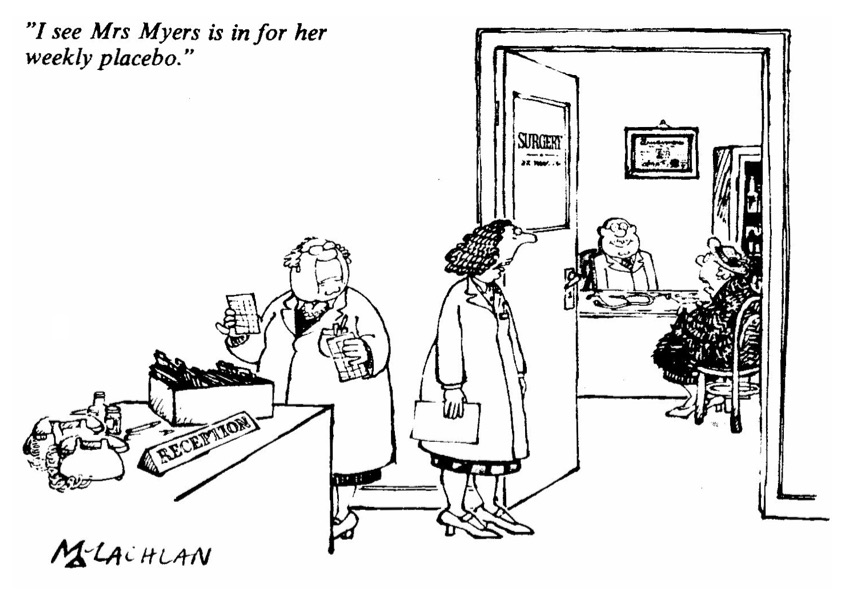
This cartoon relies on the sharp eyes of the reader insofar as the depiction of the doctor in question is a little unclear. The edges of the ‘2D’ cutout are not as visible as they might be, though the figure does contrive to look somewhat wooden as befits a cutout. Fortunately it is the nature of humour to challenge the reader, who knows perfectly well that every joke is a puzzle that you have to ‘get’, so some effort is always going to be made to spot such less than obvious giveaways, and as we have seen, the joke always benefits by posing a puzzle for us to solve. Here then are the dynamics of this cartoon.

So, if the medication given to a patient is supplied by a doctor, then when a placebo is offered to the patient, it should be supplied by the placebo equivalent of that doctor: namely a fake doctor. A simple logic that is based on the ‘just taking things a little further’ and yet one that constitutes the slippery slope of, amongst other things, madness, invention and humour. Notice incidentally that the reference to the placebo is verbal, not visual in this example. This is surely because it is almost impossible to visually differentiate real pills from placebos in a drawing (a pillbox marked ‘Placebo’ goes against the point of the placebo, and is verbal in any case). Thus it is the caption, as so often, that saves the day.
It is tempting to insert an additional arrow in the diagram above – one leading from the concept of the real doctor to the cutout doctor. That way, there are two arrows making the move from the two contextual neighbours (the Dr and his meds) to the two copies by way of two strong semantic links (Contextual neighbour and Original/Copy). In which case our diagram would look like this one below, which is why the term ‘sidestep’ is so appropriate, because we are stepping from the left side (of normal doctor relations), to the right side (the world of copies). But for the moment, the diagrams will maintain the simpler format of one arrow, simply because this makes cross twist comparisons that much easier to make.
More must be said about neighbours, now that we have looked at these two examples. For example, take that favourite British object, the teapot. The teapot is an object in Social Space, and is surrounded by a number of other objects that link to the teapot in a complex matrix of meaning. These objects are therefore the ‘neighbours’ of the teapot, and they fall into three discrete kinds. ‘Property Neighbours’ are objects like the coffee pot, the milk jug, the kettle and the watering can – because in this case they all share the property of having a spout. Then there are the ‘Context Neighbours’, including all the objects likely to be found in the vicinity of the teapot, such as the cutlery, plates, dishes and cups (the connection is spatial, which is what the term contextual means in this regard). Finally, there are the ‘Category Neighbours’ – which is a grouping that includes all the other teapots, real or imagined, that exist in Social Space. Category Neighbours are a bit like a range of very closely related species in biology, belonging in the same genus because they are rather similar, which in this case means that the teapots may vary in size, shape, substance and colour, but they all function as containers that can brew and pour tea.
Neighbours then are objects that exist in Physical Space, but they owe their real identity to the causal framework of Social Space (where cause = purpose). And because they exist primarily in Social Space, they always have a certain semantic distance from their ‘reference object’. So, for example, most of us would agree that the coffee pot is nearer to its reference object, the teapot, than is the kettle. Both coffee and tea pots are used to hold, present and pour drinks at table. Whereas the kettle belongs in the kitchen, where it’s sole task is to heat the water (and as every restaurant manager knows, preparation in the kitchen and presentation in the dining room are two very different matters). So, although the teapot, coffee pot and kettle are all property neighbours, they have a distance between them that is represented by a real physical distance between say, the kitchen and the drawing room, and it is the social distance between food preparation and food presentation that is responsible for this physical distance in the layout in the first place. On the other hand, we can also say that if we compare our teapot to the watering can in the garden, the teapot is relatively much nearer to the kettle, because although the kettle and the teapot are still part of that same general process of ‘making the tea’, the watering can provides a drink to an altogether different kind of life form. All of which is relevant to the creator of jokes because it is semantic distance that defines whether a twist is banal, novel, dramatic, or over the top.
Here is another example of a sidestep from an original, this time from the New Yorker magazine, again with a diagram summarising its dynamics.
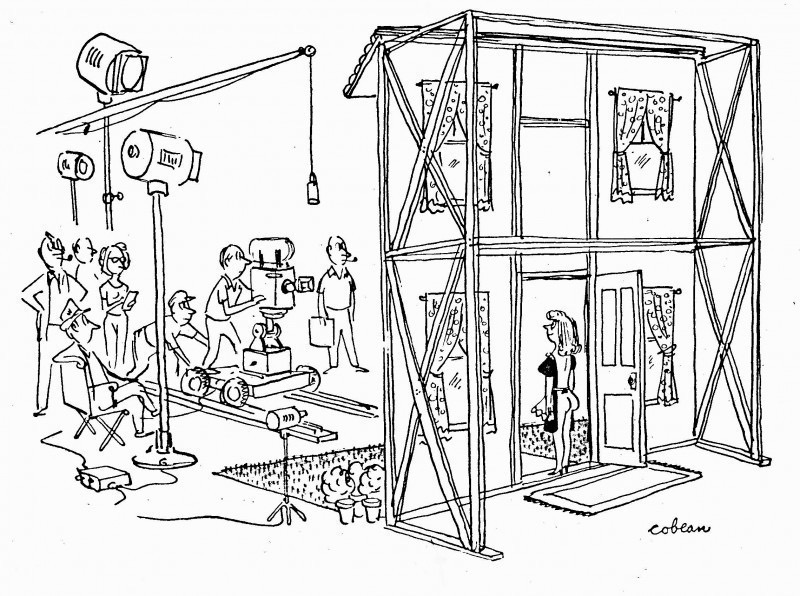
Certain locations, such as the toy shop, the art gallery, the film set and the theatre, can be referred to as a copy-rich environment. To wit, in this particular case, we find that a property of a film set has been copied by its living ‘occupant’, the actress, here dressed in the uniform of a maid. And the result is likely to appeal to an adult male readership in particular. Incidentally, we cannot be sure whether the maids uniform is a copy of an original (which is often the case with the wardrobe in a film set or theatre) or simply a maid’s uniform bought off the peg. However, the wardrobe is usually a part of this copy-rich environment of the set, providing copy costumes that are generally custom made for any particular film, albeit it with varying degrees of authenticity, so it is likely that this uniform is indeed a copy.
It is interesting to compare the path of ‘joke resolution’ with the path of ‘joke creation’ in this cartoon. We would normally expect the joke resolution to start with the result of the twist, because that is what we look for first. At which point we then move on to the logic that supports this twist. That is, we focus on the similarity between the dress and the film set facade, and from there we shift to the parallel between the original/copy pair of the building/film set, and the proposed pairing between the original costume and the modifed dress worn. It is this parallel that points to the ‘logical’ outcome of the twist, leaving us free to enjoy the result, at least for the brief moment of the joke.
The path of joke creation takes quite a different course however. It likely starts with the film set because, being a duplicate reality, and a full scale ‘copyscape’, it is already a favourite hunting ground of cartoonists. Once there, the next step is some of that ‘controlled mind wandering’ that we have referred to before. So for example, the humorist might play with the various components of the film set (context neighbours in fact) and simply pursue different lines of thought, most of which will come up with absurdities, banalities or options that might be alright, but cannot be supported. And perhaps the pervasive and characteristic copy property of the film set, which is that it lacks a back, will act as a focus for a ‘what if?’ when applied to the context neighbours nearby. The maid is just such a nearby neighbour, and it is a short step from her, to her dress, and then to a parallel modification to mimic the film set facade.
So the actress/maid has no backing to her clothing, and this follows from the stage set around her having no backing either (film and theatre sets only have to work when the camera or audience look at them from the front). But what justifies this twist? Because the cartoonist has made no effort to find an externally sourced legit for this dress ‘modification’ as far as we can see. Which means that we should probably be looking for an internally based legit instead. Well, the best justification that we find for the dress behaving like the film set facade is that it finds itself simply doing what its context neighbour is doing. That is, it seems that in the case of the sidestep twist, the means of gaining the twist also turns out to be the means of supplying the legit. Because once we spot the strong link between the O/C and O/N relationships, the parallel extension to the new copy is a natural step to make.
How can this be though? How can what is clearly an attack on the serious practicalities of a film set at the same time act as the justification for that attack? Because it is clear that the result is anything but sensible, yet it seems somehow justified. We understand why this twist is an attack on good sense, because it is clear that if the maid turns around during an action sequence, the special illusion that the set, actors and costume are all trying so hard to maintain will fall flat. But if we look for the legit, we find no external reference that might somehow support this departure from good sense, nor any obvious sign of a legit internal to the situation to lend any support either.
With the ‘Something new in a wig’ cartoon, the imitation of the negative properties of the copy is justified by putting the whole scene into the retail context, where sales people are known for their spurious claims – the legit is an external one. At the same time, copying fidelity also applies, and this is a legit internal to the O/C relationship, so perhaps this proximity is similar to the idea of the maid’s dress being part of the film set in general? The dress is literally so close to the surrounding facade that the jump from the normal copy to the modified copy is a small one…
Additionally, there is one feature that for example both the General Montez statue of his army and the Maid’s butt have in common, and that is that they are physically plausible, and therefore easy to present visually. Plausible in the sense of do-able; but not do-able in terms of what makes good sense, that is. And as we have seen with the ‘Landscape that Runs in the Rain’ cartoon, it can be enough to present the twist so convincingly that no further support is required. So do sidesteps simply rely on the physical do-ability and the visual presentability of their action for their legitimacy?
The only other aspect of the sidestep that I can see as lending support to this twist is the strength of the link between the two context neighbours. The facade and the physically proximate dress worn by the maid, are strongly connected through both their physical context (O/N) and their membership of the O/C relationship. So because the dress (whether real or from the film set wardrobe), and the facade of the house, are clearly co-conspirators in the illusion fostered for the sake of the movie, they should behave in the same way. The same applies to General Montez and his army due to their military commitment, and the placebo and doctor due to their commitment to patient care. In each case, the same commitment leads to the same behaviour, and in each case, the result is a bit silly. But the result is there for us to see, and we are bound to consider it because of the logic of the parallel arguement, even if we know that the conclusion is unworkable in real life.
One interesting thing to note about copy rich areas, like film sets, toy shops, and art galleries, is that there are many copies jostling with each other, and that these copies constitute naturally occurring sidesteps to one another. For example, side-stepping from a toy fort, back to the real fort, and then sideways to some soldiers nearby, is not going to create anything new as toy soldiers are a commonplace form of copy in this particular context already. One might say that in cases such as the toy fort, the copy rich domain is itself the result of a series of natural sidesteps. So if the humorist is to create a new sidestep within this context, it is essential to check that it cannot exist as a natural consequence of normal copy logic. That is, the sidestep has to result in a new copy that would not normally exist, and the more dramatic or silly this result, then the better the joke.
Note that this latter point about how funny the result might be is just as important a creative step in the whole process of thinking up a new joke as the step required to initially set up the sidestep twist itself. For example, if instead of the naked butt of the maid, we were shown a car that, from the backstage viewpoint, was only half a car with little stabilisers to keep it up, the joke would be far less compelling than the example above. But putting in a girl with a sneaky peak at her butt does the job nicely. So subjective choice is as inevitable as it is critical here, and though it is obvious to us which is the best choice to go with, it is rather harder to imagine how a bit of software, designed to duplicate the creative path, would manage this particular stage in the process (though any algo that ignored sexual attraction would be poor indeed).
Now here comes an interesting and tricky challenge of the sort that comes up all the time when trying to formulate the types of twist that attack a particular relationship. The question in this case being, are we really talking about a new twist in this example, or is it just another type of imitation twist? One where the copy takes on the properties of another object, and where that other object is a fellow copy? In other words, could this sidestep just be a ‘Copy Like Another Copy’ imitation twist where the dress of the maid is imitating the back-less facade of the film set? (Assuming that the dress is a part of the costume wardrobe, and therefore a copy in its own right).
The thing is, if we look at the General Montez or Placebo Doctor examples, we see immediately that in each case a new copy has been created by the sidestep twist – from scratch. Meaning that it is the new copy result, along with its origin in the O/C and O/N links, that characterises these two examples as being cases of the copy sidestep. So the question is, can the same be said of our film-set maid with her cut away dress?
Perhaps the quickest way to determine the truth in this case is to stipulate that the maids uniform is actually the genuine article, borrowed for the occasion, and therefore anything but a copy. Which means that where it has had its back removed, it is an object behaving like the copy of its neighbour, the real building. In other words, the link has been made through the step from the original dress to the original house where the maid works, and then sideways to its copy in the form of the film set facade, and back into the foreground as it were with an altered dress. (A true sidestep if ever there was one). So whether the neighbouring object happens to be a copy or an original uniform is of no great moment, because either way, it is the status it has as a nearby object (or in this case, subject) that counts as far as the sidestep twist is concerned. After all, copies do have a claim to being objects in their own right, and sometimes their copy identity does not point to an O/C twist at all. So for example in the Cave Painting cartoon, the fact that the original cave painting is itself a copy is not directly relevant to the O/C twist in that cartoon, so we should not be distracted by it when considering the twist dynamics. The conclusion must therefore be that the dress is an object that is behaving like its proximate neighbour, the copy, by being a copy itself, and taking on a property of that copy in order to achieve that comparable status. So it is not a copy behaving like another copy, it is an object behaving like a parallel object that happens, in this case, to be a copy. And as we shall see below, the sidestep twist may be made without any copies being involved at all – because there are many alternative links available, and there is always the strong link of context neighbour to bring together in one place and one action two otherwise very different objects to create a sidestep twist.
Finally, when all is sorted out, the visual presentation of a sidestep can also present its creator with some tricky problems. For example, if we copy the General Montez cartoon idea, and imagine a life size statue of Gustav Eiffel, with a 320m (that is, life size) statue of ‘La Dame de Fer’ towering behind it, then how would the viewer know that the tower was a copy, and not the real one? Because in this case, a metal model of the original would be indistinguishable from the real thing. In which case it would surely look like a statue of the man standing in front of his famous tower, and this would excite no interest whatsoever. Which is to say that for every successful sidestep, such as the General Montez cartoon, the head of every cartoonist bears the neural traces of dozens of tryouts that never made it, due to the practical difficulties encountered in presenting their logic in visual form.
If it was hard to find examples of the Original in the context of its Copy displacement twist (the bathroom duck cartoon), it was even harder to find examples of the next twist, where the sidestep supposedly takes us to a new neighbour, rather than to a new copy.

As I have never managed to locate an example of such a twist in the cartoon literature, I was obliged to do two things. Firstly to formulate any reasons that might explain this absence, and if that did not work out, try and create an example from first principles. In practice, the easiest way to do the first was to do the second, and try and create a new example, because the obstacles along the way would then hopefully show why such a twist is not, in practice, possible. And after several attempts to create an example of this twist, I came up with a scene showing that the reverse side-step is actually possible. But first here is a reminder of what we are looking for: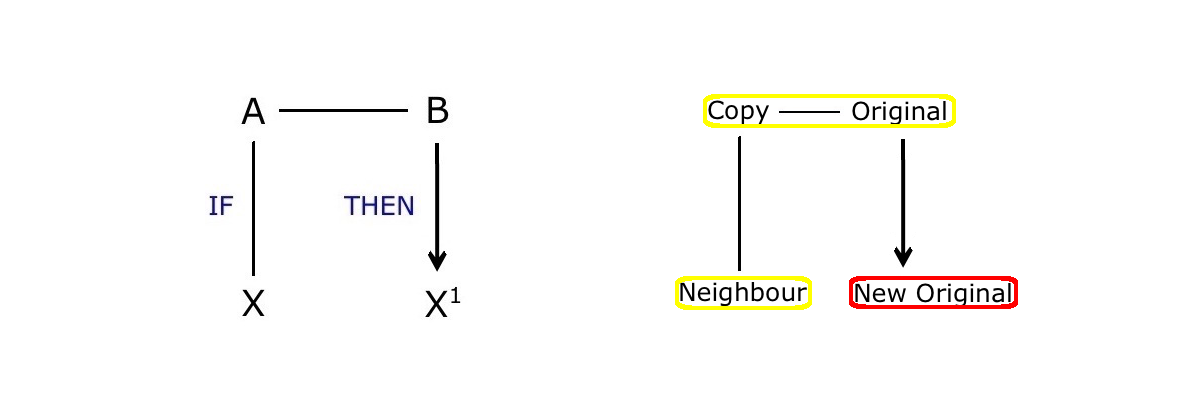
So, is it possible to reverse the sidestep twist that is exemplified by ‘General Montez’, and use the neighbour of the copy to drive the creation of a new original? At first sight this seems unlikely, given that originals are not a function of their copies, a fact that weakens the very link that has to serve as a strong parallel for the action of the twist. But then there is still a close resemblance between a copy and its original, even if it is true that the link is stronger from the original to the copy than vice versa, so perhaps this is not a factor in the scarcity of examples. Here then is what is hopefully an example of this twist, prefabricated as it were, in order for the show to carry on.
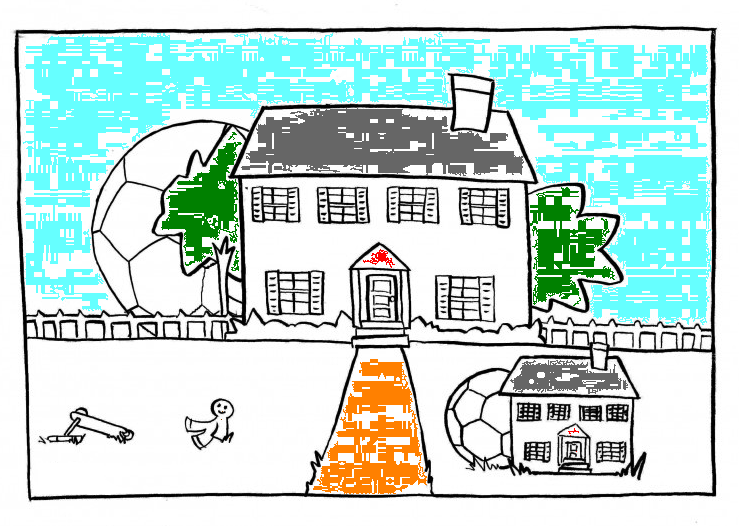
Notice that the visual presentation works better if the giant ball is a little hidden behind the house rather than out in the open – it’s always best to keep the puzzle aspect of the joke alive if possible. Interestingly, all four elements of the twist are visible in this cartoon: the original, the copy, and the copy neighbour are all present, as well as the new neighbour invented by the twist. This is not the case in the previous sidestep twist because there we see just the copy and its new neighbour, with for example, both the real General and his army absent from the picture. So why, in this opposite twist, do we find all four twist elements are necessary? Why not just show the House and Giant Ball on their own, without any reference to their copies – that is, without the kids toys in the foreground?
The answer lies in the aforementioned asymmetry between the Original and its Copy. Copies always have their originals hiding somewhere backstage, at least in our minds. But the opposite is not the case: the original does not imply the existence of a particular copy. Which means that if all reference to the dolls house and its neighbouring object, the ball, are excluded, then the logic of the sidestep is completely lost. After all, how can we guess, unaided, that the giant ball is the result of a parallel move that mirrors the move from copy to copy neighbour? The image of a normal house with a giant ball lurking behind it simply makes no sense at all without this reference. And we know that if a joke is to succeed, and offer us the alternative sense that every joke tries to create in order to claim our attention, then this other logic must be clear, or the joke fails. Which in this case, means including a full reference to the doll’s house and the neighbouring ball.
A word about this ball though. The normal ball lies within the normal scale for a football, and sits by the doll’s house, which is also the normal scale for a doll’s house. But the giant ball has been scaled up to meet the size of the normal house (just as the doll’s house is scaled back up to its original, though we would normally look at this the other way round). That is, the sidestep has taken the ‘scaling up’ of the doll’s house copy as the inspiration and justification behind the scaling up of the neighbouring ball. But what kind of object is the giant ball? Is it a copy of the original ball, or a neighbour of some kind? Well, it is not a copy of the original ball in the foreground because it does not imitate the football directly, but rather, it follows the relationship between the football and its doll’s house neighbour, in parallel with the link between the real house and its copy, the doll’s house. The giant ball is in effect a new Original – an object that exists without necessary reference to the football because balls are of all sizes, and this one happens to be massive. Nor is the normal size ball a copy, though it sits next to one, but the giant ball is certainly a new version of the normal ball, finding the justification for its new size through the O/C and O/N relationships in front of us in the cartoon. Such size balls do not exist in the normal scheme of things it is true, but they could if the need was there, so the size of the ball is not inconceivable in real life. But the logic that generated it in this instance has nothing to do with such practical matters, and is as specious as humour likes to get. (The definition of ‘specious’ is ‘plausible but wrong’, so that fits the nature of the joke rather well, with particular emphasis on the ‘plausible’ side of things).
Now, could this need to include all four elements frontstage in the picture be the reason why it is so hard to find examples of this twist in the literature? Certainly it is a limitation in one way, because the copy and its neighbour have to be plausibly present in the same context as the original for the twist to work. However, some copies do share the same context as their original, making this twist practicable in at least those situations. So the question remains. Why is there such a dearth of examples of this twist in the literature? Could it be due to the fact that many of the neighbours of the copy are themselves copies (in which case they already have originals, so the sidestep simply points us back to originals that exist already)? Well again, although this does impose another limitation, it comes nowhere near to posing an absolute barrier. And surely the creative mind of the humorist can get around such limits, because that is part of the craft of joke creation after all – the logic of meaning is not immutable. So the mystery remains, which means there is a need to keep on looking… for both examples, and for the possible reasons for the total absence of this twist in the literature.
Sidestepping the O/C relationship altogether
Is there any reason why the sidestep twist should be limited to the O/C relationship? Because surely an alternative link can be used in place of the O/C side of the logic, whilst the object/neighbour link, defined by the context, will supply the other link? Indeed, given the ubiquity of the object to neighbour link, how about using it for both sides of the sidestep? As in the following example, where there is no logical reference to Originals and Copies (despite the visual reference to an art gallery) and instead, it is the issue of both context and neighbour that we find essential to the resolution of the joke.
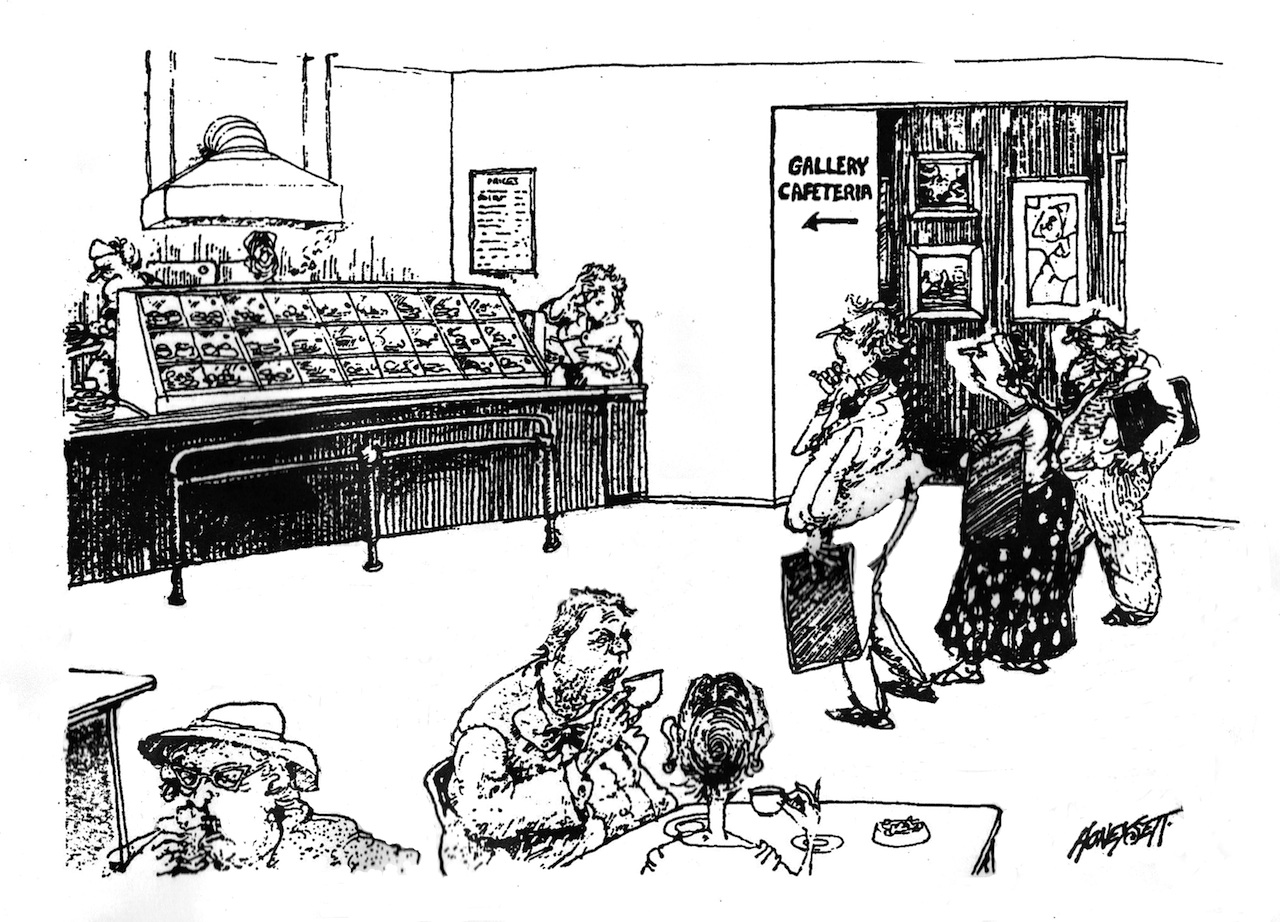
What we see here is that the twist has arranged the cafe customers in a posture normally associated with a group of critics in front of a canvas or other work of art. Whether critics or just visitors to the gallery we cannot say, but it seems they have decided to choose a meal after their viewing in the nearby gallery. Except that they are now standing in the same critical pose, used for the evaluation of the art next door, but this time in front of the food, where such an evaluation is inappropriate, and abnormal. Where then is the license for this strange behaviour? Well, the parallel supplies the legit, just as it does in the other sidesteps we have looked at (though in this case, it is between two neighbouring contexts rather than an original, and its copy). The logic as usual being that what is right in one context must therefore be right in the nearby one as well. And the result doesn’t stretch the imagination too far, because no major social or physical laws have been denied by putting the art viewers in this new position. Making the result fanciful rather than particularly clever, but at least it works, and so the small puzzle that is the twist and its justification is duly solved with very little effort.
One small but essential aspect of the visual presentation in this cartoon is worth mentioning at this point. The cartoonist could have drawn up the range of food available in the cafe in a number of ways, but only one of those ways can be the successful candidate if the joke is to be clearly and easily understood. That is, the food must be arrayed in a configuration that reminds the viewer of the parallel between the pieces of art arranged on the walls in the nearby art gallery, and the choice presented by the cafe. That visual parallel is the key element in the creation of the joke, because without it, the logic of the sidestep is lost. Fortunately, the system of using glass compartments in a vertically as well as a horizontally extended configuration is known to us, because it does actually exist in certain food outlets. (And if it did not, it does at least seem a plausible way of presenting a range of dishes to the public). So the whole thing works for both the cartoonist and the viewer, but one can easily see how such practical matters are critical to the successful birth of a joke.
How then do we organise these new dynamics into a diagram? In particular, how do we identify its components at an abstract level? Well, the gallery and cafe are clearly examples of the category ‘Context’, and as they are contiguous, they are clearly an example of two neighbouring contexts (rather than two context neighbours). So this represents a jump in the scale of things in Social Space – up to now, we have been discussing the range of objects (original/copy/neighbour), whilst here we are looking at a whole group of objects that together share the same spatial context, and comparing it with another context nearby. However, for the other component in this dynamic, the people, we drop back down again to the objects that populate such spaces, though in this case, it is hard to identify a person, or group of people, as anything other that the ‘subjects’ of the joke.
In fact the term ‘object’ is often a difficult one to use in respect of reality, partly because ‘object’ connotes of 3 dimensional solidity, and even things like the dress we looked at in the film set cartoon above are not always easy to see as objects in that respect. Whilst, as we have seen, a person is normally viewed as a ’subject’ and a shadow or the wind is certainly neither of these. Perhaps the best term to use in all these cases is ‘Element’, because this carries no particular connotations of meaning or physique, and is essentially neutral. In fact, it can always be qualified to then specify the category of element, such as object, subject, condition or for that matter, copy, original, or context neighbour. So bearing this in mind, here is one possible diagram for the ‘Cafe Critics’ cartoon.

This makes the action of the joke plainly visible, because we immediately see how the move from Context to Neighbouring Context parallels the move in logic from the Gallery, and its Visitors, to the Cafe, and its Visitors. The arrow shows the action of the twist, but it is tempting to insert another arrow into this diagram, this time between the gallery and the cafe, in order to show the sideways movement of the joke logic that then results in the all important parallel between the two sides. Either way, the links mirror the logic of the joke, but two arrows would make the direction of its argument clear, showing the narrative where the visitors have literally moved from the gallery to the cafe, taking the ‘critical pose’ with them in the process. But hold on a moment. Surely, this move looks very much like the move we would expect to see in a displacement twist in that case? So which is it: a sidestep, or a displacement twist?
The logic of ‘If A does this, then B can do this too’ is common to both the sidestep and displacement twist. So is there a difference in the focus of the twist? One that makes the Art Gallery Cafe a sidestep rather than just another displacement? For example, if we look at the General Montez cartoon, there is a clear difference between the two possibilities of displacement and sidestep, because the result of the twist is a new copy that would not normally exist in practice. But in the art gallery cartoon, we are just transferring the critics from one context to another context nearby, which is just like the Money in the Meter cartoon, where the toy car is moved from the play area to the street, and parked there as if it had the status of a real car. And at least in this latter example, there is a finer logic to the twist – where the link is less literal, and more to do with a higher level of human design, and not just simply based on spatial proximity. Nor do we find any new objects in the Money in the Meter, or the Art Gallery Cafe cartoons, but just the same old toy car, and the same old critics doing their usual thing (just in a different place). For which the conclusion must be that the Art Gallery Cafe is a displacement, and not a sidestep twist. In which case it is better to represent its dynamics in a way that at least partially corresponds to the O/C displacement diagram. Which seems right because the primary pair in this twist is surely the initial context of the art gallery, with its implied citizen critics, whilst the move to the new context of the cafe, justified by its proximity to the picture gallery, gives us the accompanying displacement of the elements of that original context – the critics.
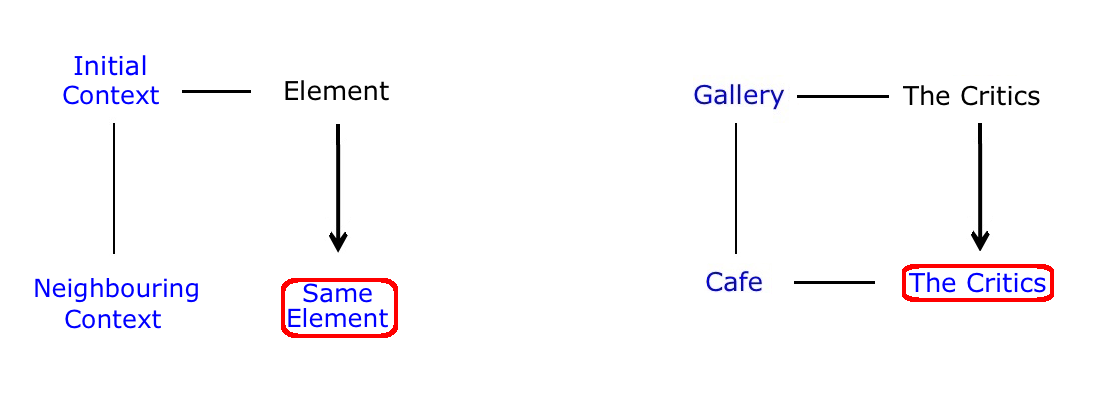
Much more can be said about the way the diagrams work and don’t work at this stage. But it is a start, and the diagrams do help to make any errors in the analysis easier to locate and define. But progress is being made. Jokes are being shown to consist of relationships that are being twisted in some way, so that the dynamics of the joke can be simplified into the four corners of a diagram, with the twist result occupying the bottom right in each case, this representing the point that must then usually find some kind of support from either inside or outside the relationship, or even both, for the joke to properly succeed in our eyes. The relationship between the Original and its Copy is steadily being revealed as we move through the different examples of its use in cartoon humour, and other points about aspects of objects in social space are also becoming clear – the role of property, context and neighbour being the principle threesome that concern us here. The role of the twist and the legit, and the evaluation of the relative quality of a joke area also under the spotlight already, and before we go on to investigate further aspects of the O/C natural history of twists, it is worth putting the complete array of the twists covered so far into a comparative format. So firstly, the imitation, displacement and sidestep twists that play with the copy side of the relationship are put side by side, along with their primary examples as illustration.
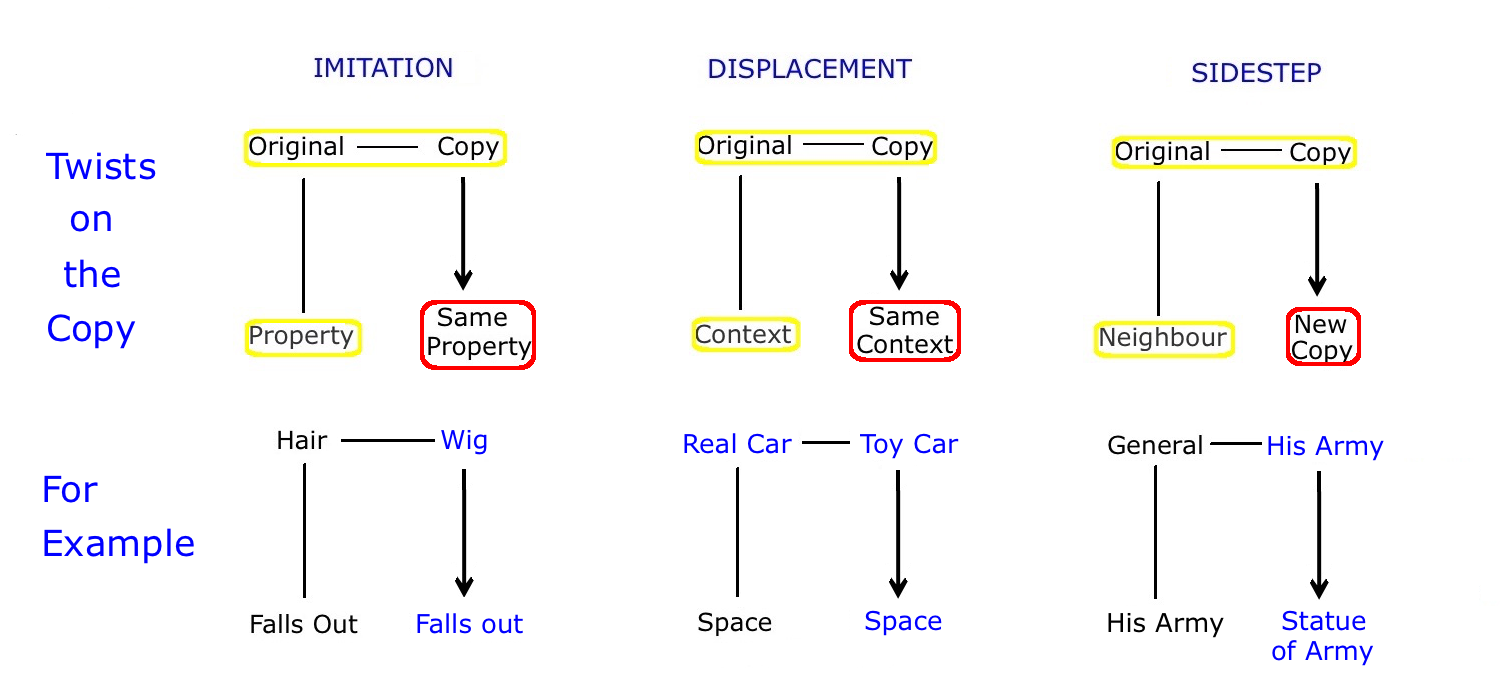
One point raised by this exposition of O/C twists is the terminology for the results in the red boxes. To wit, it seems that the red boxes cannot decide whether the twist give us a new result, or the same result. Well, perhaps the best overall description is indeed ‘new’ because for example, the wig takes on a ‘new’ property (‘Something new…’ is the caption after all), and although it is the same property as far as its original is concerned, it is clearly new to the copy. The same applies to the toy car, because a real parking space really is a new context for such a copy. Again, the same applies to the General Montez cartoon as we can see from the schema for the sidestep above, but we could argue that the statue is more of the ‘same’, (and that just the subject is different), so either terms are applicable in this case too. But for good measure, in the next set of twists, where the focus is on the originals, only the term ‘new’ is used for the results.
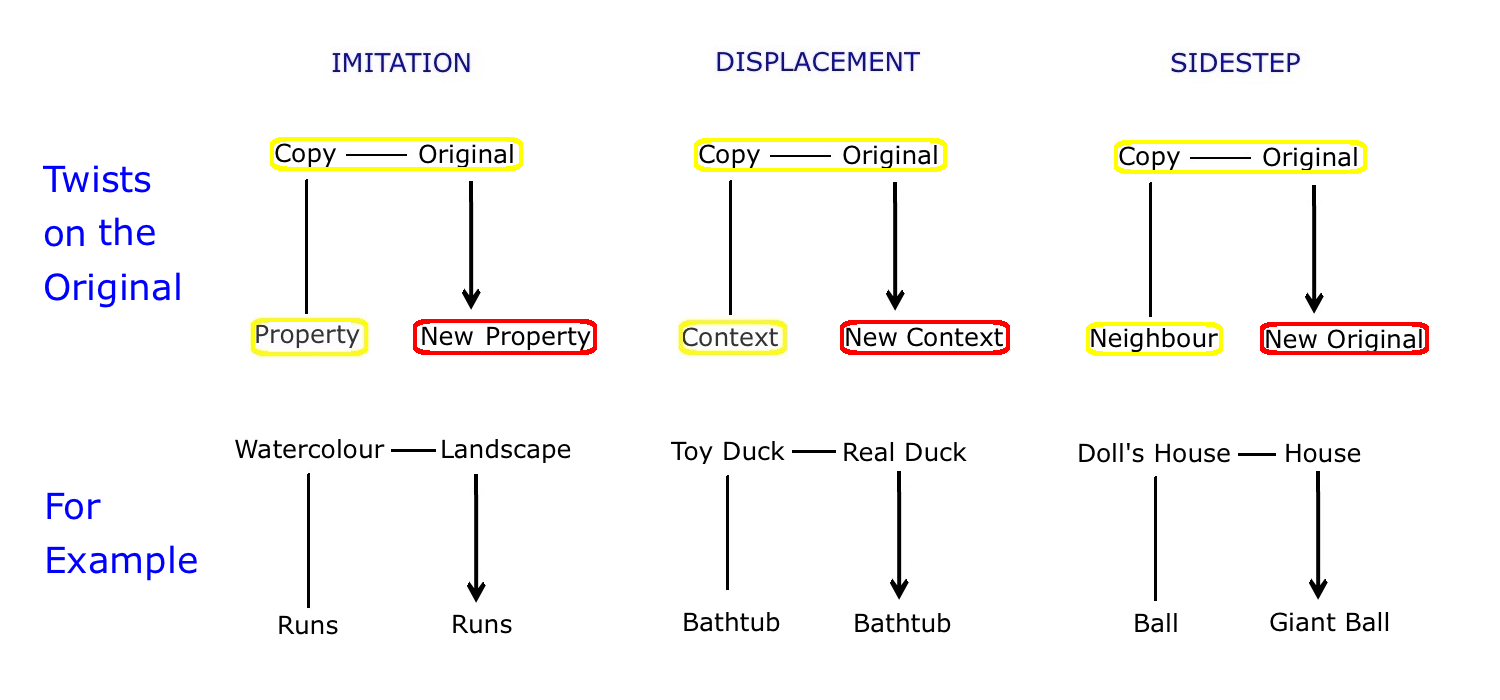
Another issue in the arrangement of such diagrams is the placing of the arrows. And as we have seen earlier in this discussion, the sidestep schema seems to benefit from two arrows from left to right, given that the logic relies on a parallel extension between the two sides for its creation, resolution and appreciation, so perhaps there is room for improvement in the diagrams in that direction. But a much greater issue concerns the logic square from AX to BX, because if it applies to all three twist pairs, might this then suggest a more universal dynamic for jokes in general? Or is it just that in using this schema, the rest of the analysis follows it, taking its shape from it, and seeming to corroborate it, when really it has no choice but to do just that? That is, the whole analysis has somehow become an artefact of the initial logical pathway, and this pathway is therefore not proven by what follows on from it.
Such questions are doubtless important, but it is now time to pursue another category of Original/Copy twists – this time to do with the relative status of the two parties.
